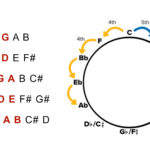“My guitar is not a thing,” Joan Jett famously stated. “It is an extension of myself. It is who I am.” This sentiment resonates with countless musicians and fans alike, encapsulating the profound connection between a guitarist and their instrument. The guitar, a truly universal instrument, offers both immediate accessibility and endless depth. Anyone can learn basic chords quickly, yet a lifetime isn’t enough to fully explore its vast sonic potential. This inherent duality is what makes discussions about the greatest guitarists so captivating.
In 2011, Rolling Stone initiated this very discussion by publishing its inaugural list of the 100 Greatest Guitarists. This compilation was curated by a panel of musicians, predominantly seasoned classic rock veterans. Now, Rolling Stone has expanded this exploration, presenting a new, more comprehensive list of 250 guitarists, assembled by the magazine’s editors and writers.
Guitarists often attain iconic status comparable to the lead singers of their bands. While legendary guitar heroes like Jimmy Page, Brian May, and Eddie Van Halen are integral to the guitar narrative, they represent only a fraction of its full spectrum. This expanded list aims to showcase the remarkable breadth of the guitar’s evolution. Spanning over a century, the list includes artists from Elizabeth Cotten (born in 1893), a folk music pioneer, to Lindsey Jordan (born in 1999), an indie-rock prodigy. The featured genres are equally diverse, encompassing rock, jazz, reggae, country, folk, blues, punk, metal, disco, funk, bossa nova, bachata, Congolese rumba, and flamenco, among others. The selection celebrates both unparalleled virtuosos such as Pat Metheny, Yvette Young, and Steve Vai, and raw, primal players like Johnny Ramone and Poison Ivy of the Cramps. It honors mainstream icons like Prince, Joni Mitchell, and Neil Young, alongside unsung heroes like Memphis soul luminary Teenie Hodges and smooth-rock master Larry Carlton.
Recognizing the collaborative nature of music, the list acknowledges the power of guitar duos, including Kim and Kelley Deal of the Breeders, Adrian Smith and Dave Murray of Iron Maiden, and other synergistic pairings who share a single entry. The primary criterion for inclusion remains focused on the six-string guitar, celebrating its unique voice and versatility.
In crafting this list, Rolling Stone prioritized certain qualities: heaviness over technical finesse, emotional resonance over polished perfection, innovation over mere refinement, and a preference for artists who channeled their talents into impactful songs and groundbreaking albums, rather than just technical prowess.
As modern blues innovator Gary Clark Jr. eloquently put it, “I don’t know if I want to get too far off the path — I don’t want to get lost in the forest — but I like to wander out a bit and adventure.” This spirit of exploration and innovation is what defines the greatest guitar players.
Elmore James
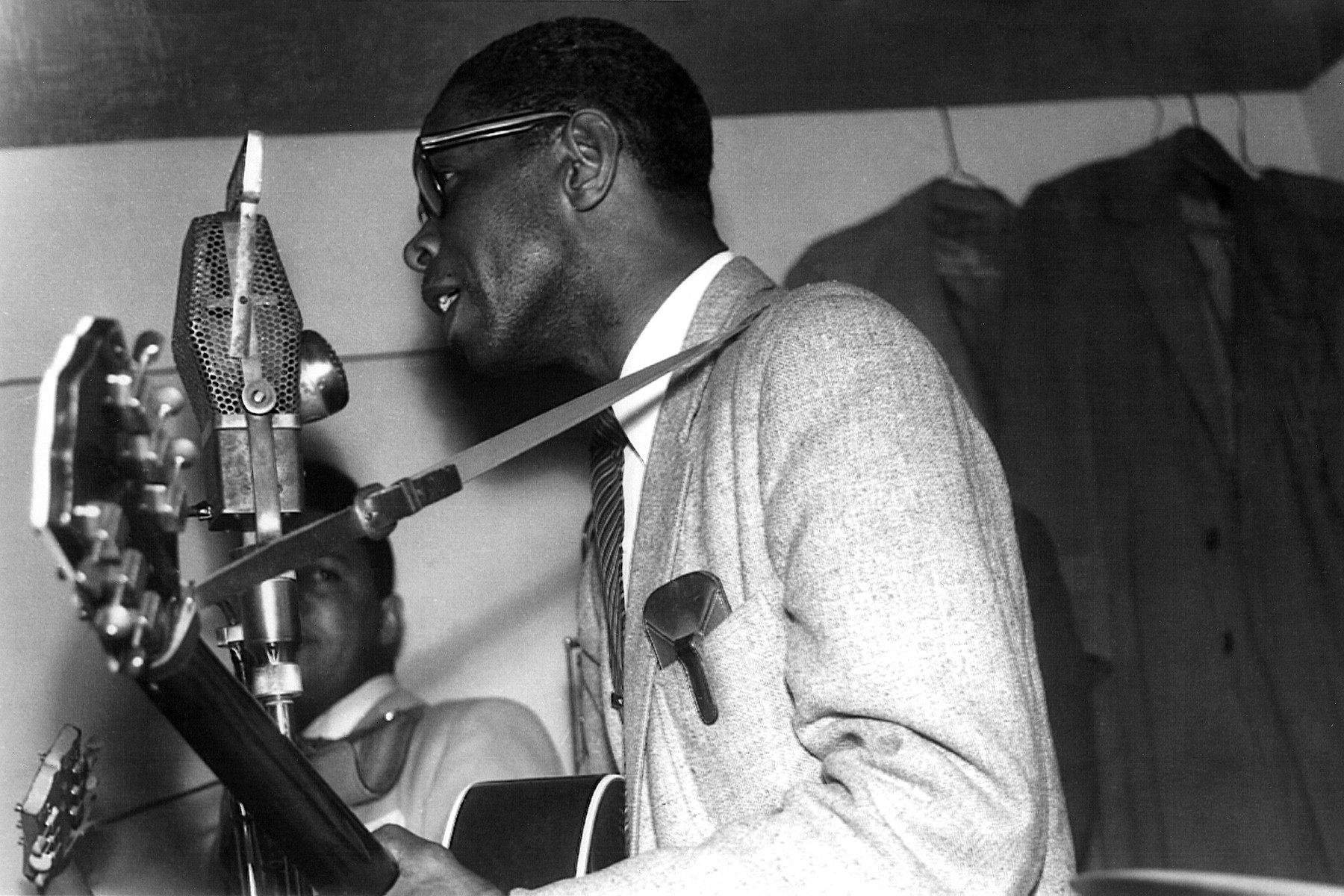 American blues guitarist Elmore James playing slide guitar, circa 1960.
American blues guitarist Elmore James playing slide guitar, circa 1960.
Mississippi-born Elmore James, a singer and guitarist, is renowned for a single, yet iconic guitar lick: the staccato, descending slide riff that defines his 1951 rendition of Robert Johnson’s “I Believe I’ll Dust My Broom.” As slide guitar virtuoso Derek Trucks notes, “It was a great lick. There was something unleashed in his playing, that acoustic guitar with the electric pickup. When he’s singing, you hear his voice through the electric pickup.” James further solidified this signature lick with electrifying variations in tracks like “Shake Your Moneymaker” and “Stranger Blues.” These songs became essential blues standards during the blues revival era, particularly after his untimely passing in 1963. Elmore James’ distinctive tone profoundly influenced a generation of guitarists. Robbie Robertson confessed, “I practiced 12 hours a day, every day, until my fingers were bleeding, trying to get the same sound as Elmore James got. Then somebody told me that he plays with a slide.” His raw, amplified acoustic sound remains instantly recognizable and deeply influential in blues and rock guitar playing.
Key Tracks: “Dust My Broom,” “The Sky Is Crying”
PJ Harvey
 PJ Harvey performing live in Belgium in 2001.
PJ Harvey performing live in Belgium in 2001.
Polly Jean Harvey, known as PJ Harvey, reflected on her early connection with the guitar in a recent New Yorker interview: “I often think back to that time when I first got a guitar, when I was 16 or 17… Prior to that, I’d written lots of words. When I saw that I could put words together with music, I remember it feeling like gates opening, this joy.” This sense of liberation and creative exploration is palpable in PJ Harvey’s groundbreaking early albums, such as Dry and Rid of Me. In these records, she wielded her guitar with a raw, almost weapon-like intensity. Over three decades, her playing has evolved, becoming more fluid and nuanced, yet it retains its visceral emotional power. She consistently pushes her sonic boundaries, stating, “I really don’t have any interest in just doing something I’ve done before. What excites me is uncovering something I feel like I haven’t heard anywhere.” PJ Harvey’s guitar work is characterized by its fearless experimentation and commitment to sonic innovation, making her a vital and enduring figure in alternative music.
Key Tracks: “Missed,” “Autumn Term”
Curtis Mayfield
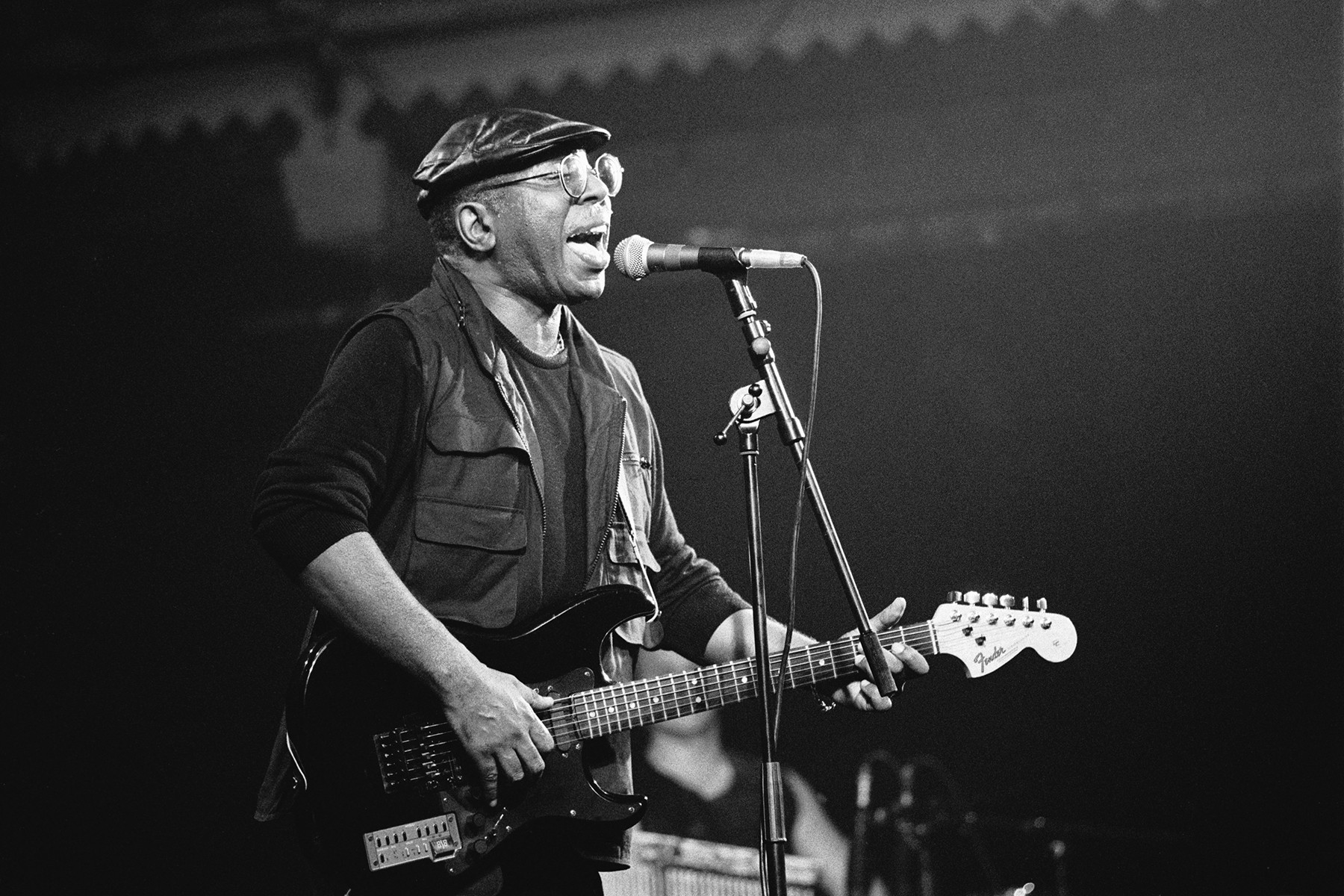 Curtis Mayfield performing at Paradiso, Amsterdam in 1990.
Curtis Mayfield performing at Paradiso, Amsterdam in 1990.
Curtis Mayfield, a towering figure in American soul music, excelled as a singer, songwriter, and producer. He also stands as a subtly influential guitarist. His gentle, flowing melodies and fills, heard in tracks like The Impressions’ “Gypsy Woman,” left a lasting impression, particularly on Jimi Hendrix, shaping his psychedelic balladry. George Clinton affirmed Mayfield’s impact: “In the Sixties, every guitar player wanted to play like Curtis.” Mayfield reinvented his guitar style during his solo career in the 1970s. He built his new sound around flickering funk rhythms and sparse, expressive wah-wah infused lead lines, exemplified in his Superfly soundtrack and hits such as “Move on Up.” His fluid chord progressions were uniquely challenging to replicate, partly because Mayfield primarily used an open F-sharp tuning. He explained, “Being self-taught, I never changed it. It used to make me proud because no matter how good a guitarist was, when he grabbed my ax, he couldn’t play it.” This unique tuning contributed to his distinctive and instantly recognizable guitar voice in soul and funk music.
Key Tracks: “Gypsy Woman,” “Move on Up,” “Freddie’s Dead”
The Edge
 The Edge of U2 performing at Feyenoord Stadion, Rotterdam in 1987.
The Edge of U2 performing at Feyenoord Stadion, Rotterdam in 1987.
As a young guitarist in the 1970s, The Edge immersed himself in a diverse range of genres, from punk and new wave to funk, blues, and R&B. He synthesized these influences into a distinctive and innovative style within U2’s early work. His signature sound heavily relies on delay, echo, and reverb, creating atmospheric and spacious textures. In a 2016 Rolling Stone interview, he described his intuitive approach to music: “I’m not a theoretical musician or a theoretical writer. I’m a hands-on guy who pursues music in a naïve way. I just love when I’m carried away by the sounds that are happening. And I draw inspiration so much from sonics, I’m a much better guitar player when shit is sounding good.” The Edge refined his sonic palette on The Joshua Tree, then dramatically shifted direction in the 1990s, incorporating krautrock and club music elements into his playing. Joe Bonamassa aptly notes his unique ability: “There are few guitarists who can identify themselves with chords alone. The Edge can — with a single strum and inflection.” His ability to create instantly recognizable soundscapes through innovative use of effects and minimalist yet impactful chord work makes him one of the most distinctive guitarists in rock.
Key Tracks: “Sunday Bloody Sunday,” “Where the Streets Have No Name”
Frank Zappa
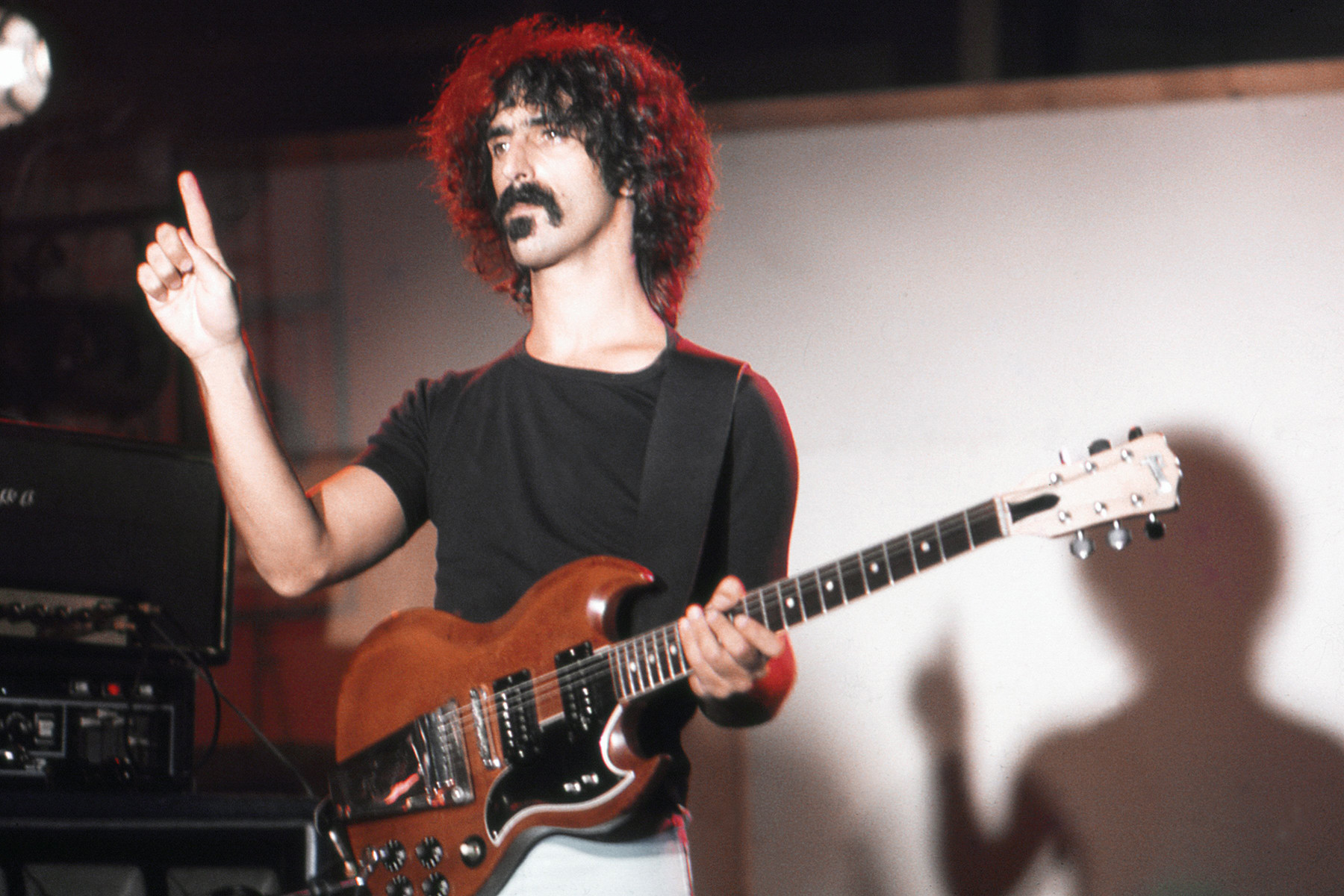 Frank Zappa in his studio in Los Angeles, 1974.
Frank Zappa in his studio in Los Angeles, 1974.
Trey Anastasio of Phish vividly recalls his formative guitar influences, stating in 2005 about Frank Zappa’s Shut Up ‘n’ Play Yer Guitar, a 1981 compilation of intricate solos: “When I was learning how to play guitar, I was obsessed with that album. Every boundary that was possible on the guitar was examined by him in ways that other people didn’t.” As the uncompromising leader of his bands, including the legendary Mothers of Invention, Zappa fused seemingly disparate genres – doo-wop, urban blues, big-band jazz, and orchestral modernism – with an iron will and boundless creativity. As a guitarist, he drew from this eclectic palette, improvising with a fervent and unrestrained joy. His extended solo on “Willie the Pimp,” from 1969’s Hot Rats, is a prime example: a sprawling studio jam brimming with greasy distortion, wah-wah textures, and agitated blues runs. Zappa’s guitar playing is characterized by its technical brilliance, genre-bending experimentation, and sheer improvisational audacity, making him a true iconoclast of the instrument.
Key Tracks: “Willie the Pimp,” “In-a-Gadda-Stravinsky”
Steve Cropper
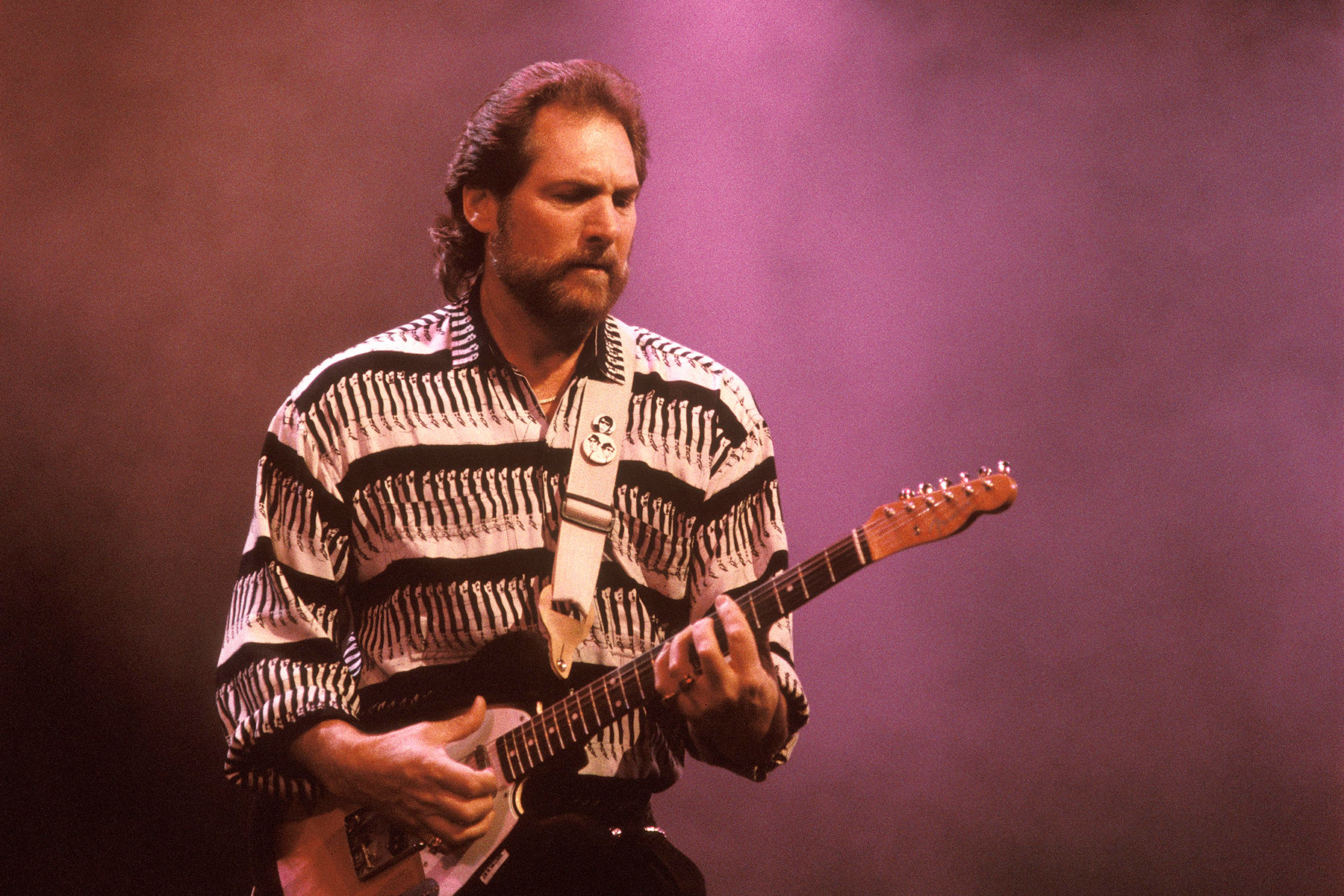 Steve Cropper in the United Kingdom.
Steve Cropper in the United Kingdom.
Peter Buck of R.E.M. succinctly captures Steve Cropper’s guitar genius: “probably my favorite guitarist of all time. You can’t think of a time when he really ripped off a hot solo, but he just plays perfectly.” Cropper is the quintessential “musician’s musician,” the secret ingredient behind countless classic rock and soul songs. As a teenager, he scored his first hit with the Mar-Keys (“Last Night”). He then spent the majority of the 1960s with Booker T. and the MG’s, the legendary Stax Records house band that provided the rhythmic backbone for hits by Carla Thomas, Otis Redding, and Wilson Pickett. His spare, soulful guitar style has graced recordings by a vast array of R&B and rock artists, including a notable stint with the Blues Brothers band. Consider the iconic intro to Sam and Dave’s “Soul Man,” the explosive bent notes in Booker T.’s instrumental hit “Green Onions,” or the delicate, filigreed guitar fills in Otis Redding’s “(Sittin’ on) The Dock of the Bay” – all bear Cropper’s unmistakable signature, the epitome of soul guitar. Cropper himself emphasizes his band-centric approach: “I don’t care about being center stage. I’m a band member, always been a band member.” His understated yet profoundly impactful playing defines the sound of soul guitar.
Key Tracks: “(Sittin’ on) The Dock of the Bay,” “Green Onions,” “Soul Man”
Johnny Ramone
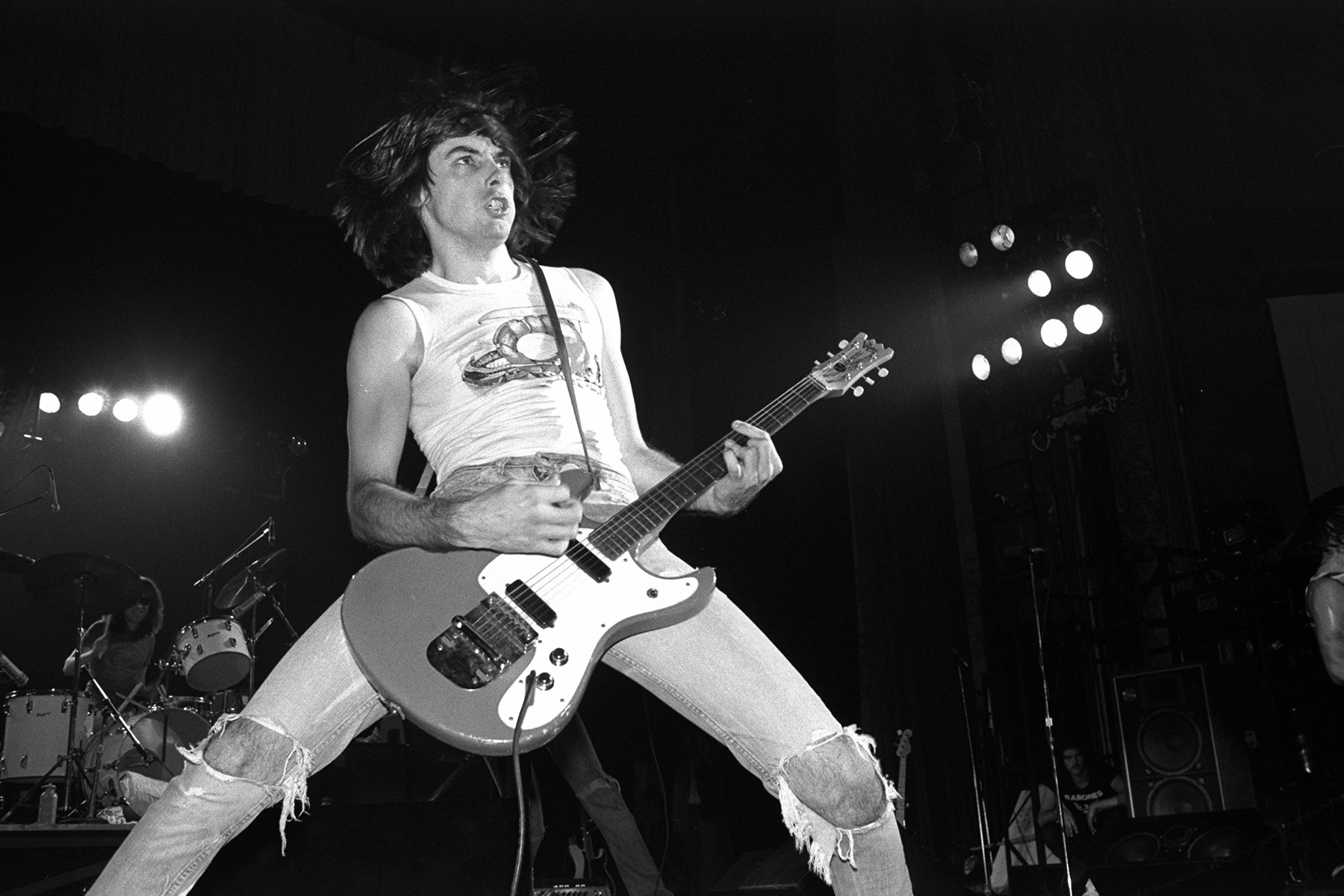 Johnny Ramone performing live at The Palladium, New York in 1978.
Johnny Ramone performing live at The Palladium, New York in 1978.
Johnny Ramone stands as the father of punk rock guitar and a significant influence on riff-driven modern metal. He is a true anti-hero of the instrument. Born John Cummings, he crafted his iconic sound using an inexpensive Mosrite guitar, hammering out rapid-fire, all-downstroke barre chords in a slashing, minimalist style that became known as “buzzsaw” guitar. A pure rhythm engine, Ramone almost never played a traditional solo, yet his playing possessed the relentless momentum of a runaway train. In an era where “heavy” often equated to “slow,” the primitive, metronomic drive of his riffs in “Blitzkrieg Bop” and “Judy Is a Punk,” and the bouncy-yet-grinding energy of “Rockaway Beach” demonstrated that speed and power could coexist. Surprisingly, his own guitar hero was Jimmy Page, a stark contrast to his own stripped-down approach. Henry Rollins vividly describes the impact of seeing Ramone play: “Johnny was the first guitar player I ever saw play like he was really mad. And I was like, ‘Damn. That’s cool.’” His raw energy and minimalist power redefined guitar playing for punk and beyond.
Key Tracks: “Blitzkrieg Bop,” “Judy Is a Punk,” “Rockaway Beach”
Jonny Greenwood and Ed O’Brien
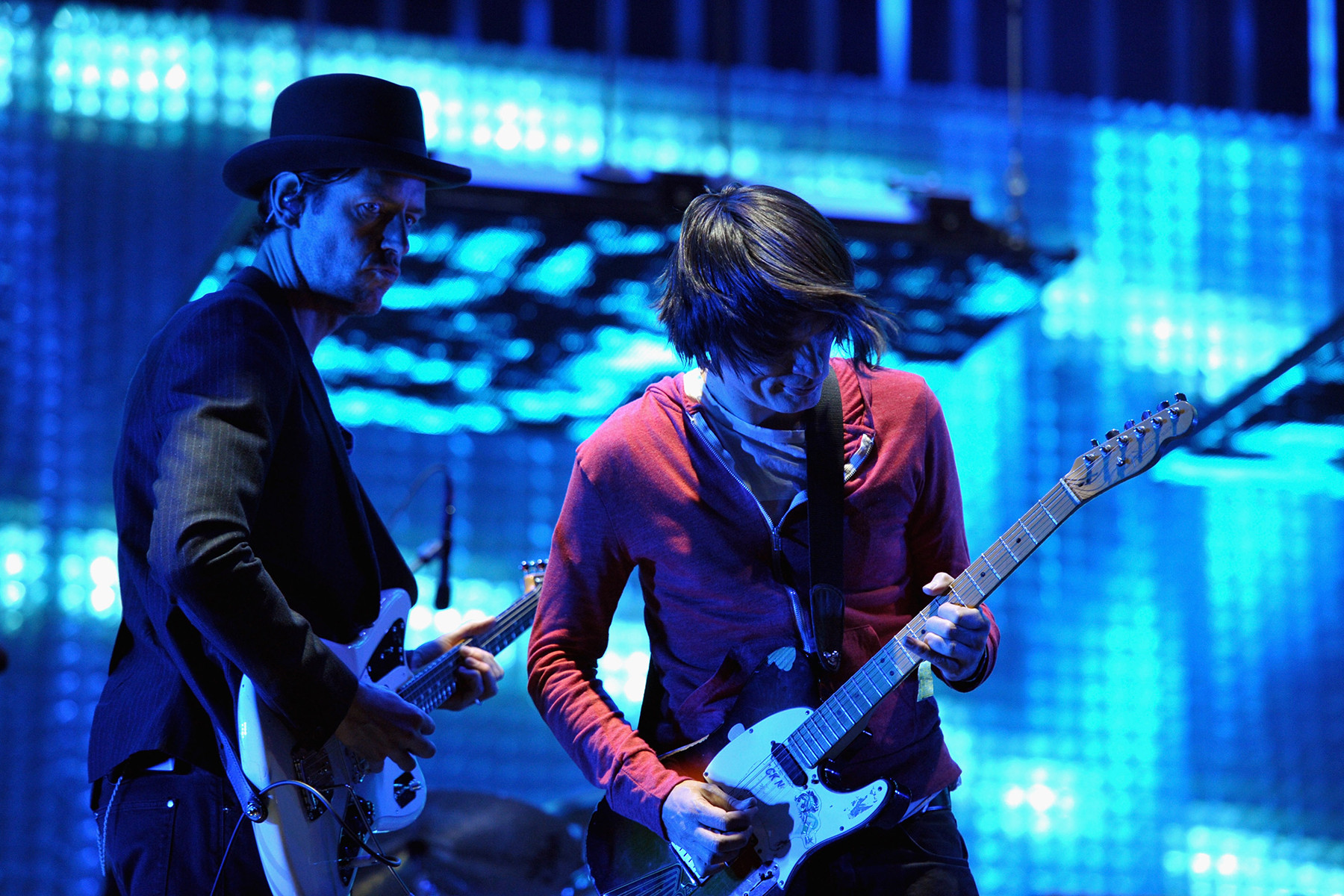 Jonny Greenwood and Ed O'Brien of Radiohead performing live.
Jonny Greenwood and Ed O'Brien of Radiohead performing live.
From the aggressive “chunka-chunka” rhythm before the chorus of “Creep” to the piercing high-frequency squeal in the “Just” solo, Jonny Greenwood displayed an early inclination towards unconventional and experimental guitar techniques. His intensely physical playing style in Radiohead’s early days even led to him wearing a wrist brace. However, Greenwood’s musical interests quickly expanded beyond conventional guitar rock. “Guitar’s not really important to me,” he surprisingly stated to Guitar magazine in 1997, the same year Radiohead released the groundbreaking and guitar-centric “Paranoid Android.” While he has evolved into a celebrated neo-classical composer, Greenwood consistently integrates at least one strikingly original and boundary-pushing guitar part into each Radiohead album. Alongside him is Ed O’Brien, often cited as one of rock’s most underrated guitarists. O’Brien’s role in Radiohead is crucial: he adds subtle, textural layers that enrich each song, providing harmonic depth and a cheerful, grounded presence. While he may not be known for flashy solos, Ed O’Brien’s atmospheric and supportive guitar work is integral to Radiohead’s distinctive and innovative sound. Together, Greenwood and O’Brien represent a dynamic and forward-thinking approach to guitar within modern rock.
Key Tracks: “Creep,” “Paranoid Android,” “I Might Be Wrong”
Vernon Reid
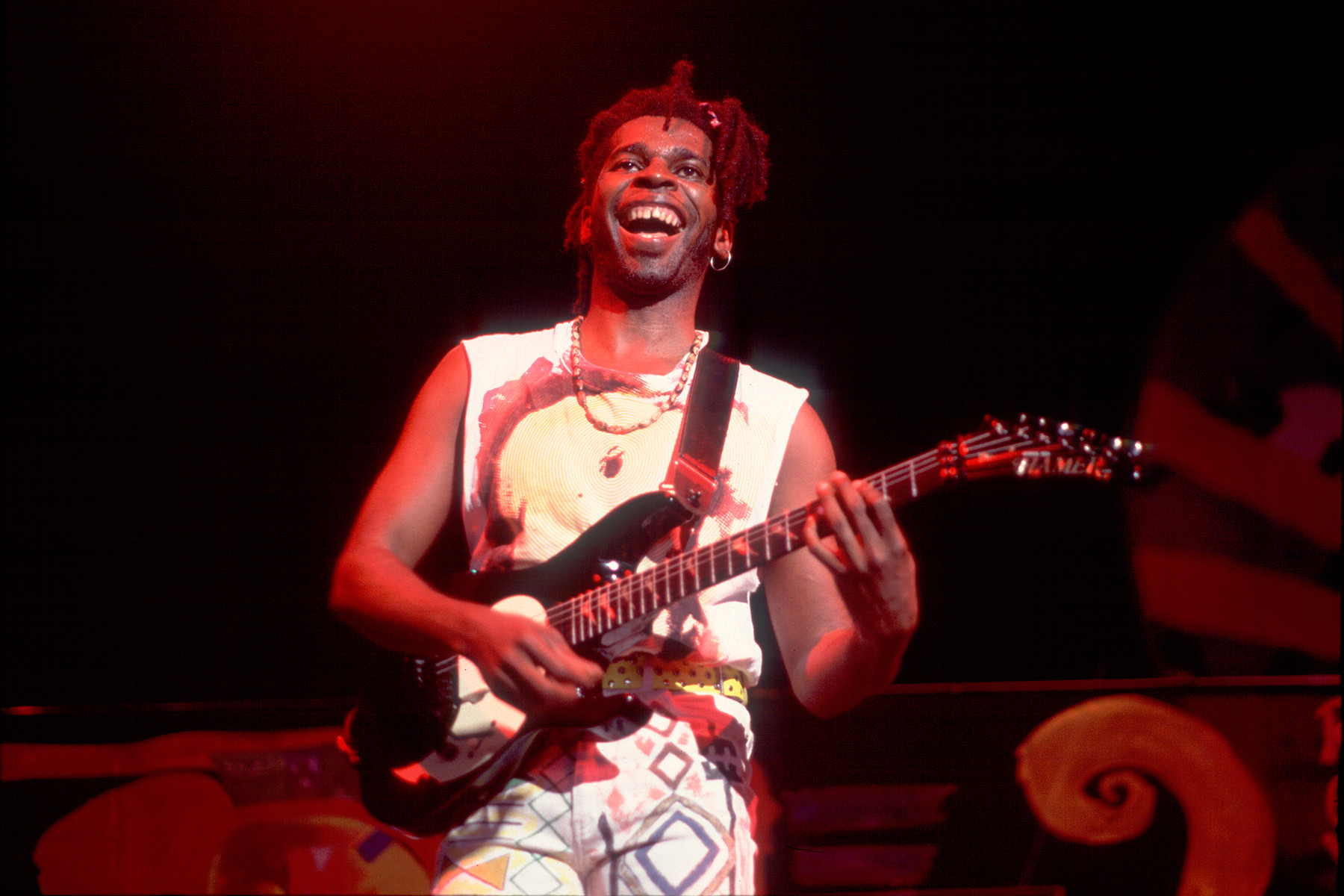 Vernon Reid of Living Colour performing in Tinley Park, Illinois in 1991.
Vernon Reid of Living Colour performing in Tinley Park, Illinois in 1991.
Living Colour emerged in the 1980s as a vital force, reminding the music world that Black musicians were central to rock music, a crucial message amplified by their MTV stardom. Vernon Reid, Living Colour’s lead guitarist, was pivotal in this. He demonstrated how a guitarist versed in jazz, fusion, and funk could inject those diverse influences into searing hard rock. Reid initially gained recognition in the early 1980s playing with avant-garde drummer Ronald Shannon Jackson’s band. His powerful riffing on Living Colour’s hit “Cult of Personality” showcases just one facet of his versatility. He also explores speed-metal intensity in “Times Up” and delivers virtuosic shredding in tracks like “Funny Vibe.” His diverse talents have led to collaborations with artists ranging from Mick Jagger to John Zorn. As evidenced by Living Colour’s 2017 album, Shade, Reid continues to command an impressive arsenal of effects and sonic textures. Vernon Reid’s career embodies the fusion of diverse musical styles within a hard rock framework, making him a truly innovative and influential guitarist.
Key Tracks: “Cult of Personality,” “Pride,” “Funny Vibe”
Bo Diddley
 Bo Diddley performing live with his rectangular guitar.
Bo Diddley performing live with his rectangular guitar.
“It’s the mother of riffs,” declares guitarist Johnny Marr, referring to the “Bo Diddley beat.” This rhythm, pioneered by Chicago guitarist Ellas Otha Bates, known as Bo Diddley, is foundational in rock and roll. Driven by Diddley’s heavily tremoloed guitar, songs like “Mona” and “Bo Diddley” unleashed a potent, amplified version of a West African groove, passed down through generations. After Diddley, this rhythmic innovation was adopted by artists from Buddy Holly to the Rolling Stones (who famously covered “Mona” in 1964), and later by garage rock and punk bands, all drawn to its raw simplicity and infectious energy. Dan Auerbach of the Black Keys emphasizes its accessibility: “Anybody who picked up the guitar could do it. If you could keep a beat, you could play Bo Diddley.” Keith Richards acknowledges Diddley’s groundbreaking style: “His style was outrageous… it suggested that the kind of music we loved didn’t just come from Mississippi. It was coming from somewhere else.” Bo Diddley’s rhythmic innovations and raw, primal guitar sound were crucial in shaping the foundations of rock and roll.
Key Tracks: “Bo Diddley,” “Road Runner,” “Who Do You Love?”
John Fahey
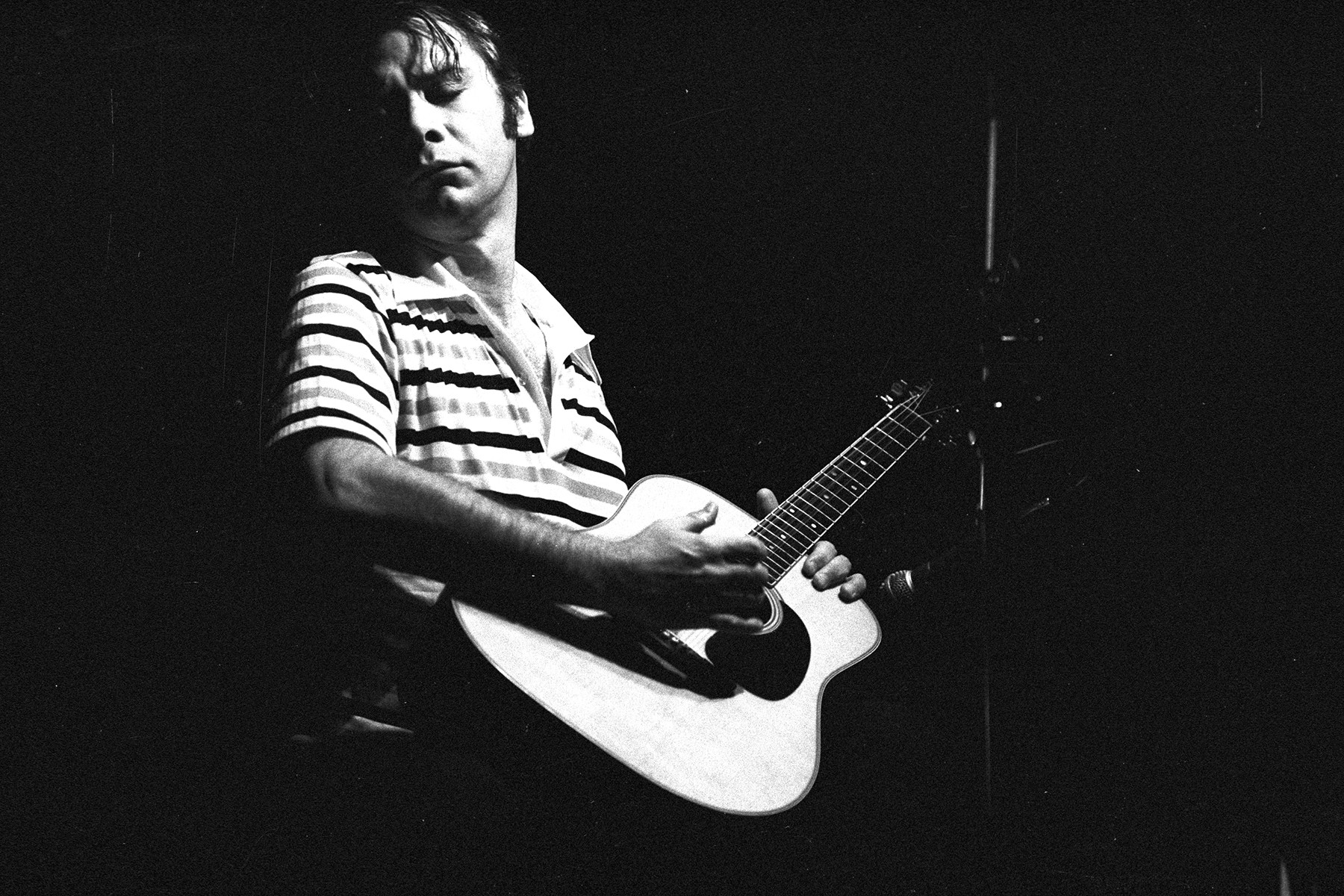 John Fahey in the United States.
John Fahey in the United States.
John Fahey, who passed away in 2001 at age 61, was a singular figure in American folk guitar. He was a masterful fingerpicker who transformed traditional blues structures with the sophisticated harmonies of modern classical music, all infused with a playful, prankster-like sensibility. “His music speaks of a boundless freedom,” remarked former Captain Beefheart guitarist Gary Lucas. Fahey recorded seminal albums such as 1965’s The Transfiguration of Blind Joe Death and 1968’s The Voice of the Turtle for his own Takoma label. He was also a respected musicologist and scholar. In the 1990s, Fahey shifted to a stark, minimalist electric guitar style, gaining recognition as a post-punk icon. Thurston Moore of Sonic Youth highlighted his significance: “To be validated by John Fahey was really special for our scene.” John Fahey’s unique blend of folk, blues, classical, and avant-garde elements, combined with his technical mastery and eccentric persona, cemented his status as a visionary and influential guitarist.
Key Tracks:“Poor Boy,” “The Yellow Princess”
Chet Atkins
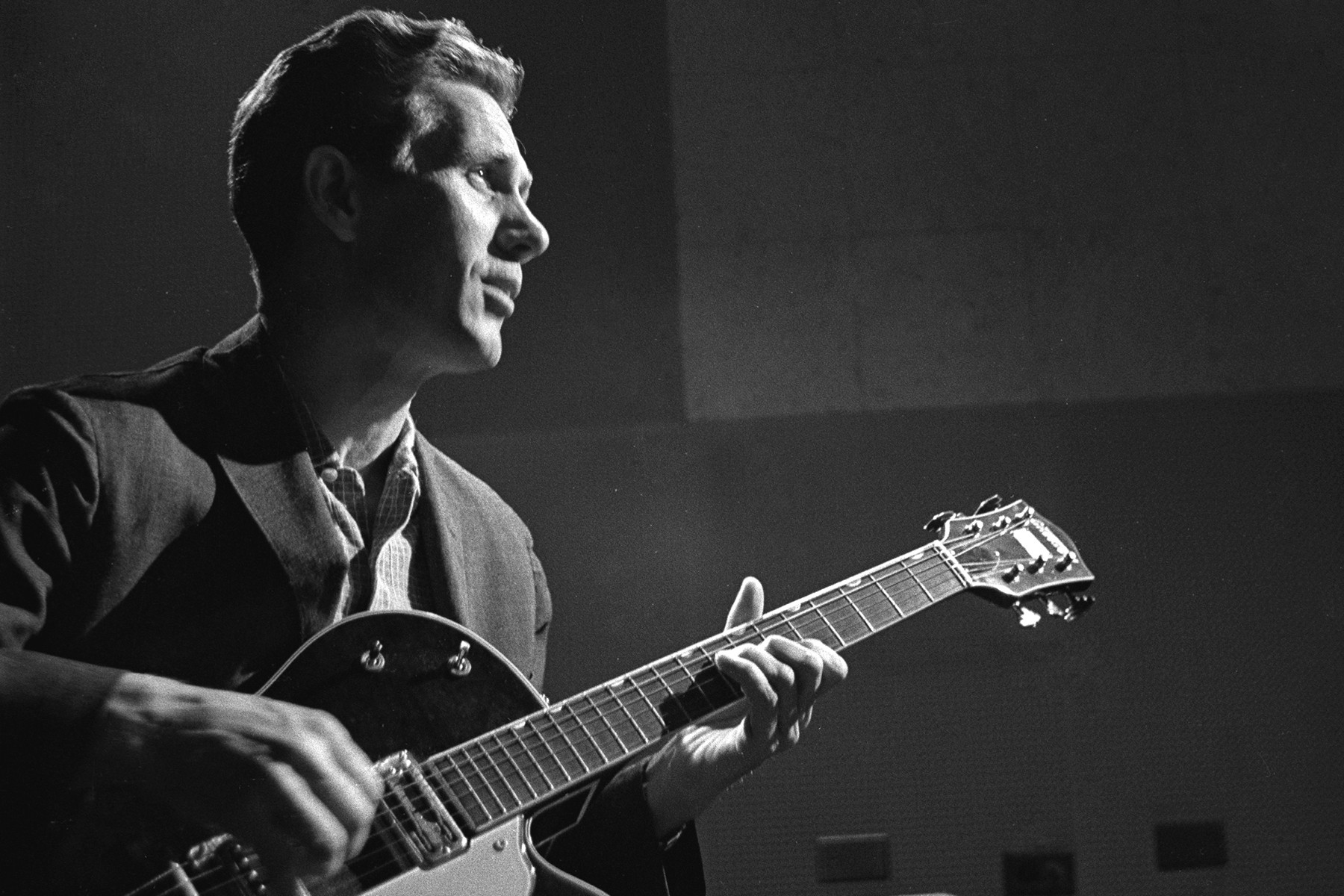 Chet Atkins playing guitar at RCA Recording Studios, Nashville in 1960.
Chet Atkins playing guitar at RCA Recording Studios, Nashville in 1960.
Chet Atkins, as a record executive and producer in the 1960s, was instrumental in creating the commercially successful “Nashville sound,” revitalizing country music. However, his guitar playing was even more transformative. He mastered country, jazz, and classical styles, perfecting a distinctive thumb-and-three-finger picking technique that allowed him to simultaneously play chords and melody. Atkins described his experimental approach in a 1976 Rolling Stone interview: “A lot of it was trial and error. I just had a damn guitar in my hands 16 hours a day, and I experimented all the time.” Atkins could be subtly restrained, as heard on iconic recordings like Hank Williams’ “Your Cheatin’ Heart,” Elvis Presley’s “Heartbreak Hotel,” and early Everly Brothers hits. However, his instrumental solo albums are treasure troves of guitar innovation, blending harmonics, arpeggios, and pure melodic lines with a remarkably clear tone. Duane Eddy succinctly stated his widespread influence: “I think he influenced everybody who picked up a guitar.” Chet Atkins’ versatile technique and innovative approach to guitar profoundly impacted generations of musicians across genres.
Key Tracks: “Your Cheatin’ Heart,” “Wake Up Little Susie”
Angus Young and Malcolm Young
 Angus and Malcolm Young of AC/DC performing in Boston in 1978.
Angus and Malcolm Young of AC/DC performing in Boston in 1978.
AC/DC’s 1990 anthem, “Thunderstruck,” embodies a unique musical fusion, blending the precision of Mozart with the raw blues energy of John Lee Hooker. Angus Young delivers the song’s iconic, lightning-fast classical ostinato, while his brother, Malcolm Young, lays down the band’s bedrock with foundation-shaking blues riffs. This dynamic partnership between Angus’s flamboyant stage presence and Malcolm’s unwavering rhythmic solidity propelled AC/DC to global fame, as much as the vocal charisma of Bon Scott and later Brian Johnson. For every hard-hitting riff Malcolm anchored, like in “Highway to Hell” or “Back in Black,” Angus, the energetic schoolboy stage persona, unleashed high-voltage solos that made him an instant guitar hero. Their combined power is undeniable in anthems like “Whole Lotta Rosie,” “If You Want Blood (You’ve Got It),” and “For Those About to Rock,” creating a sonic force entirely their own. The Young brothers’ symbiotic guitar partnership is central to AC/DC’s signature sound and enduring appeal.
Key Tracks: “Whole Lotta Rosie,” “Back in Black,” “Highway to Hell”
Pete Townshend
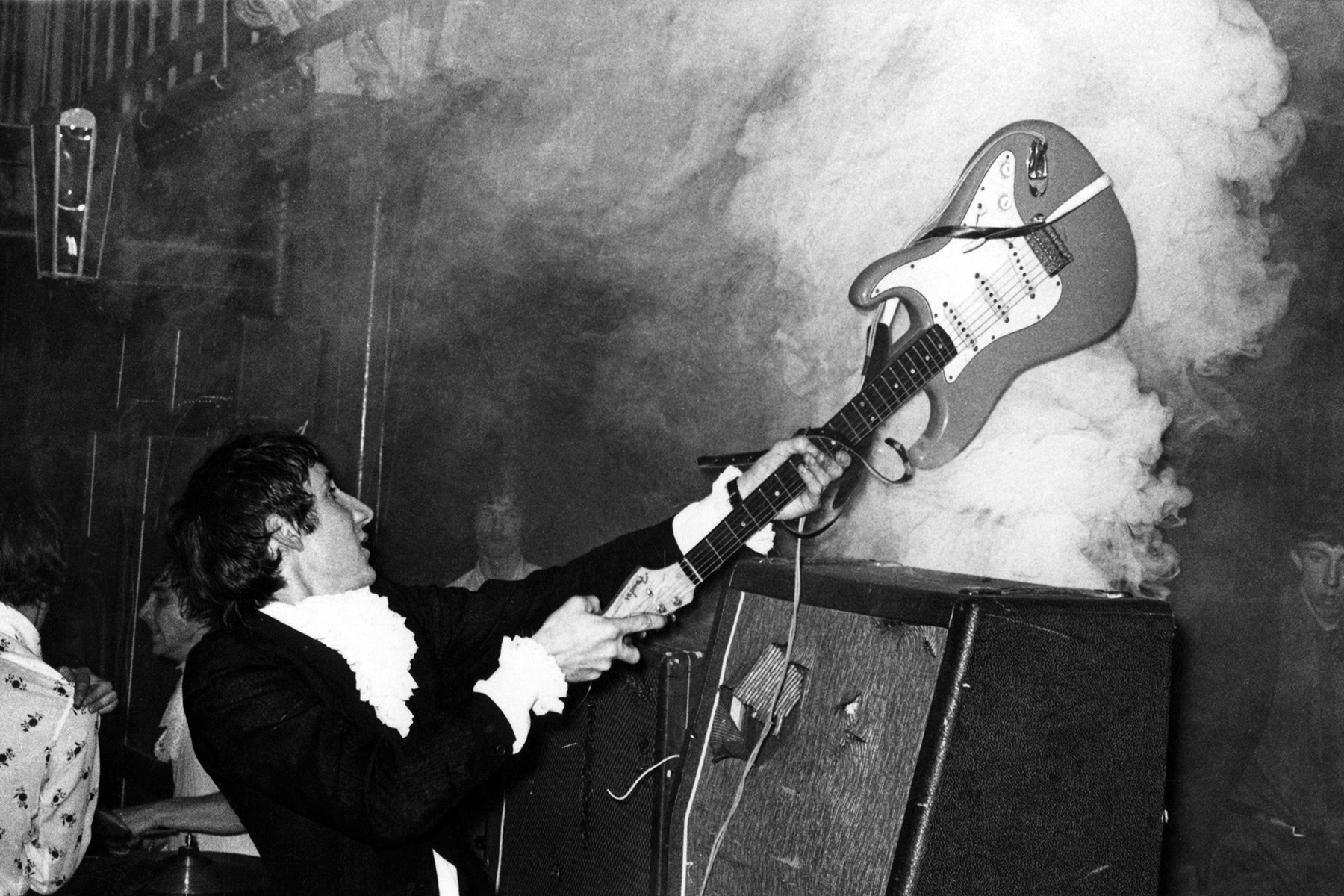 Pete Townshend of The Who smashing his guitar on stage.
Pete Townshend of The Who smashing his guitar on stage.
Pete Townshend, guitarist for The Who, didn’t invent power chords—guitar blasts reduced to the root and fifth notes—but he was instrumental in defining modern guitar heroism by demonstrating their immense sonic potential. The opening flourish of “Won’t Get Fooled Again,” a wall of A and E notes played across all six strings, is a prime example. Townshend was among the first to musically exploit amplifier feedback, and his emphasis on powerful riffs and songwriting over conventional solos (though his lead playing is often underrated) made him a Woodstock-era icon embraced by the punk generation. But Townshend’s playing extended far beyond brute force. His sophisticated use of drone notes and chord inversions in songs like “Substitute” and “Pinball Wizard” showcases his musical depth. The Who’s live performances, particularly during their Live at Leeds era, were always more intense than their studio recordings, foreshadowing the heavier sounds of Zeppelin, heavy metal, and punk rock. Pete Townshend’s innovative use of power chords, feedback, and dynamic songwriting shaped the landscape of rock guitar.
Key Tracks: “My Generation,” “I Can See for Miles,” “Summertime Blues”
Elizabeth Cotten
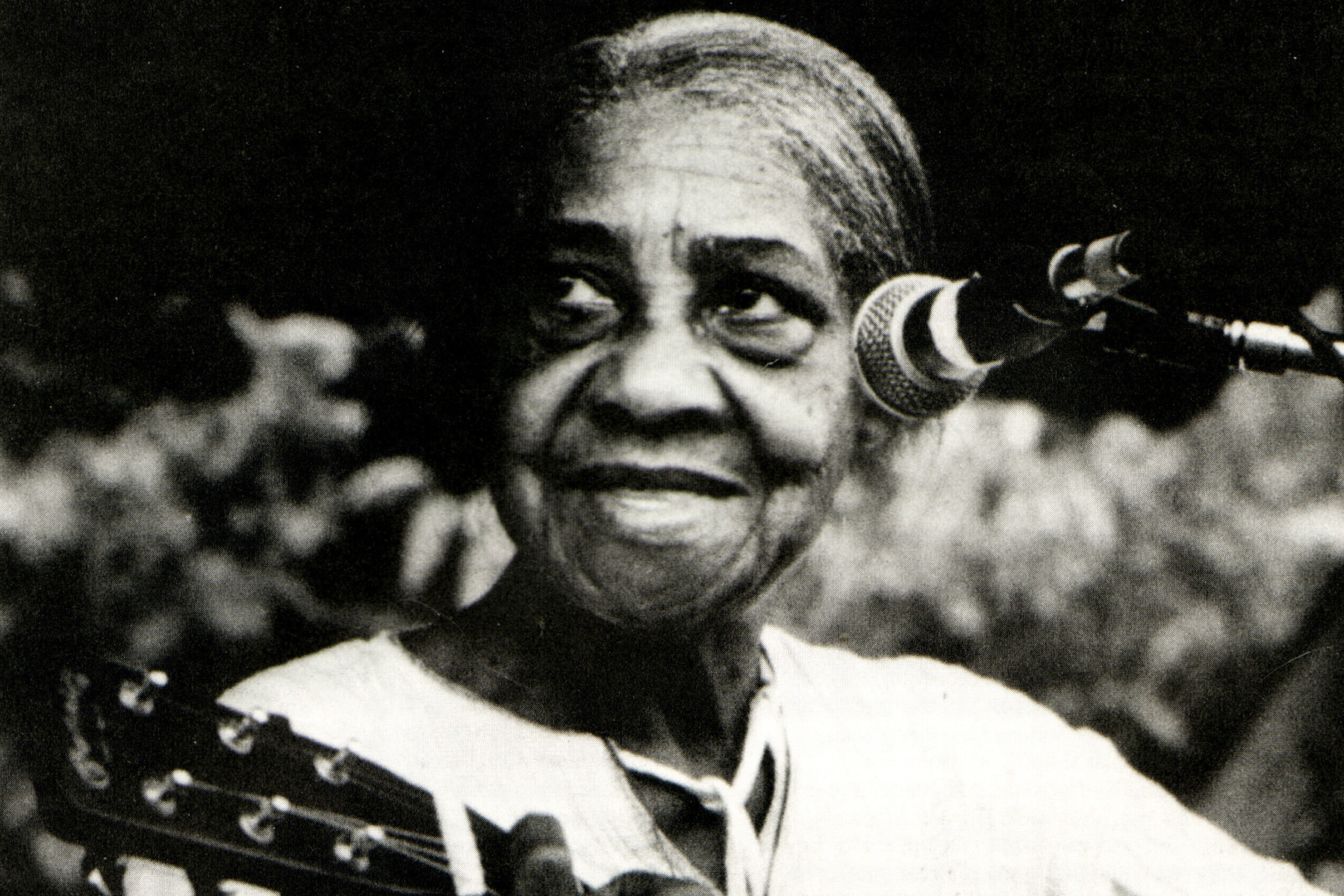 Elizabeth Cotten, American blues and folk musician.
Elizabeth Cotten, American blues and folk musician.
Elizabeth Cotten’s distinctive guitar style was born from her self-taught approach. Left-handed, she began learning on a right-handed guitar, simply flipping it over without restringing. This unconventional method led to her unique rhythmic technique, alternating fingerpicked bass notes with thumbed melodies, exemplified in her famous composition “Freight Train.” She explained her unique approach to the San Diego Reader in 1981: “It’s just my comfort, the way I’m doing everything, not what everyone else did. I couldn’t do it the other way. I tried it the other way and I could hardly strum.” Rediscovered during the 1960s folk revival after decades away from music, Cotten’s unique fingerpicking style became highly influential. Posthumously inducted into the Rock and Roll Hall of Fame in 2022 as an Early Influence, Elizabeth Cotten’s legacy lies in her distinctive technique and her enduring contribution to folk and blues guitar.
Key Tracks: “Freight Train,” “Going Down the Road Feeling Bad”
Eric Clapton
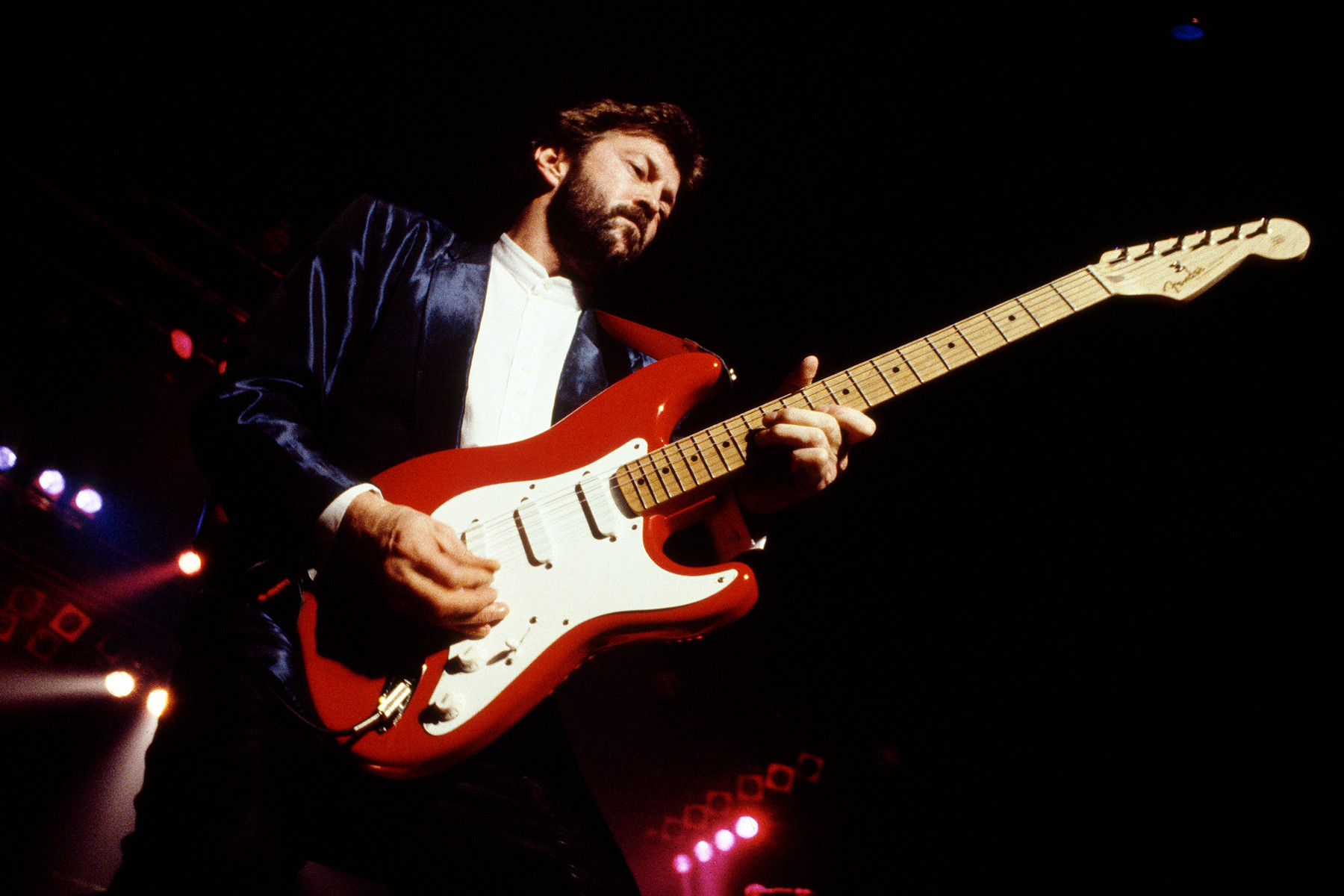 Eric Clapton performing in Rome, Italy in 1986.
Eric Clapton performing in Rome, Italy in 1986.
Since his emergence in the British blues-rock scene of the 1960s, Eric Clapton has possessed a remarkable gift for melody, making his guitar solos as memorable as the songs themselves. A dedicated student of the blues, from Robert Johnson and Muddy Waters to Albert King and Otis Rush, he even recorded an album of pre-electric blues repertoire with Wynton Marsalis. However, his most enduring recordings often stemmed from personal tragedy, from “Layla,” inspired by his love for Patti Boyd, his best friend George Harrison’s wife, to “Tears in Heaven,” a lament for his young son’s tragic death. While the “Clapton is God” era may be past, his influence on guitarists remains undeniable. His blues-infused style, melodic phrasing, and emotionally charged playing continue to inspire and captivate musicians and fans worldwide.
Key Tracks: “Bell Bottom Blues,” “Crossroads,” “White Room”
Jerry Garcia
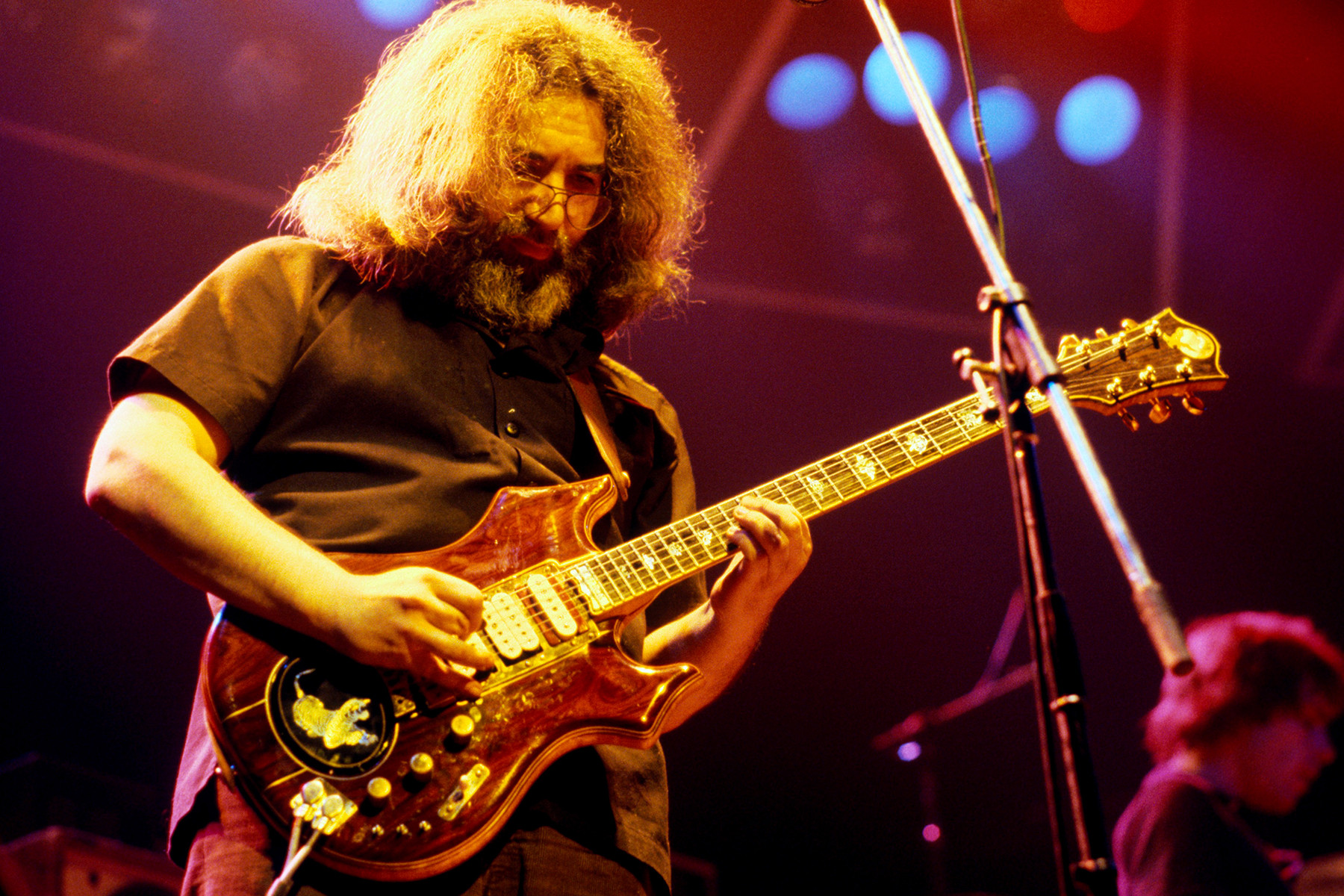 Jerry Garcia of The Grateful Dead performing in London in 1972.
Jerry Garcia of The Grateful Dead performing in London in 1972.
Jerry Garcia, a lifelong enthusiast of folk and bluegrass who began playing guitar at 15, blended these roots with a deep love of Chuck Berry to fuel his psychedelic explorations with the Grateful Dead. Carlos Santana described his unique fusion: “He played blues but mixed it with bluegrass and Ravi Shankar. He had country and Spanish in there.” Garcia made each Grateful Dead performance a unique sonic journey, famously never playing the same lick twice. This improvisational spirit is why their live psychedelic jams remain endlessly listenable. “I think of notes as objects that have perspective,” he once told Rolling Stone. “They have the front part of them and the back part of them, the attack and the release. To me, it’s very visual. If I had the time, I would illustrate all my solos.” A legendary performance from August 27, 1972, in Veneta, Oregon, is often cited as a pinnacle of Garcia’s live guitar work. Though he passed away in 1995, Jerry Garcia’s improvisational brilliance and genre-bending approach to guitar continue to inspire musicians and define the jam band scene.
Key Tracks: “Dark Star” (2/27/69), “Bird Song” (8/27/72), “Morning Dew” (5/8/77)
Brian May
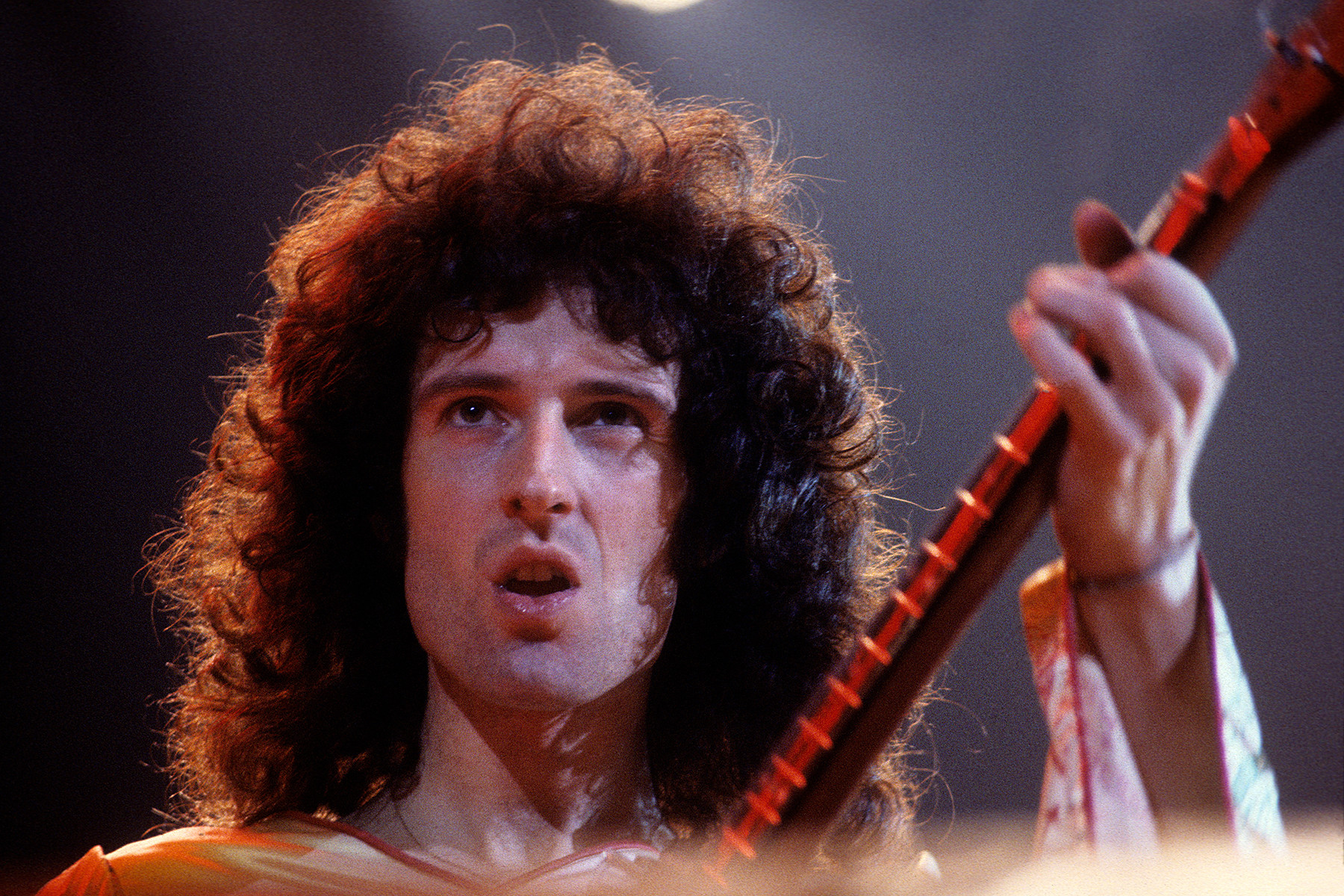 Brian May of Queen performing in Oakland in 1978.
Brian May of Queen performing in Oakland in 1978.
Brian May, Queen’s lead guitarist and a frequent songwriter, holds a Ph.D. in astrophysics, reflecting his intellectual curiosity and adventurous spirit, which extends directly to his guitar playing. An early ambition was “to be the first to put proper three-part [guitar] harmonies onto a record,” as exemplified by the orchestrated guitar squeals in his solo for “Killer Queen.” May meticulously layered dozens of guitar parts, creating vast, orchestral walls of sound. His primary instrument, the “Red Special” or “Old Lady,” is a testament to his ingenuity. Homemade with his father in the early 1960s from repurposed materials including fireplace wood, it has become as iconic as May himself. He is known to play it with a sixpence coin instead of a traditional pick. The Red Special has produced sounds ranging from the pirouetting, trebly solo in “Bohemian Rhapsody” to the proto-metal riffing of “Stone Cold Crazy.” Steve Vai acknowledges May’s unparalleled originality: “I can listen to any player and pantomime their sound, but I can’t do Brian May. He’s just walking on higher ground.” Brian May’s innovative guitar harmonies, unique instrument, and distinctive tone make him one of rock’s most recognizable and respected guitarists.
Key Tracks: “Keep Yourself Alive,” “Brighton Rock”
Jack White
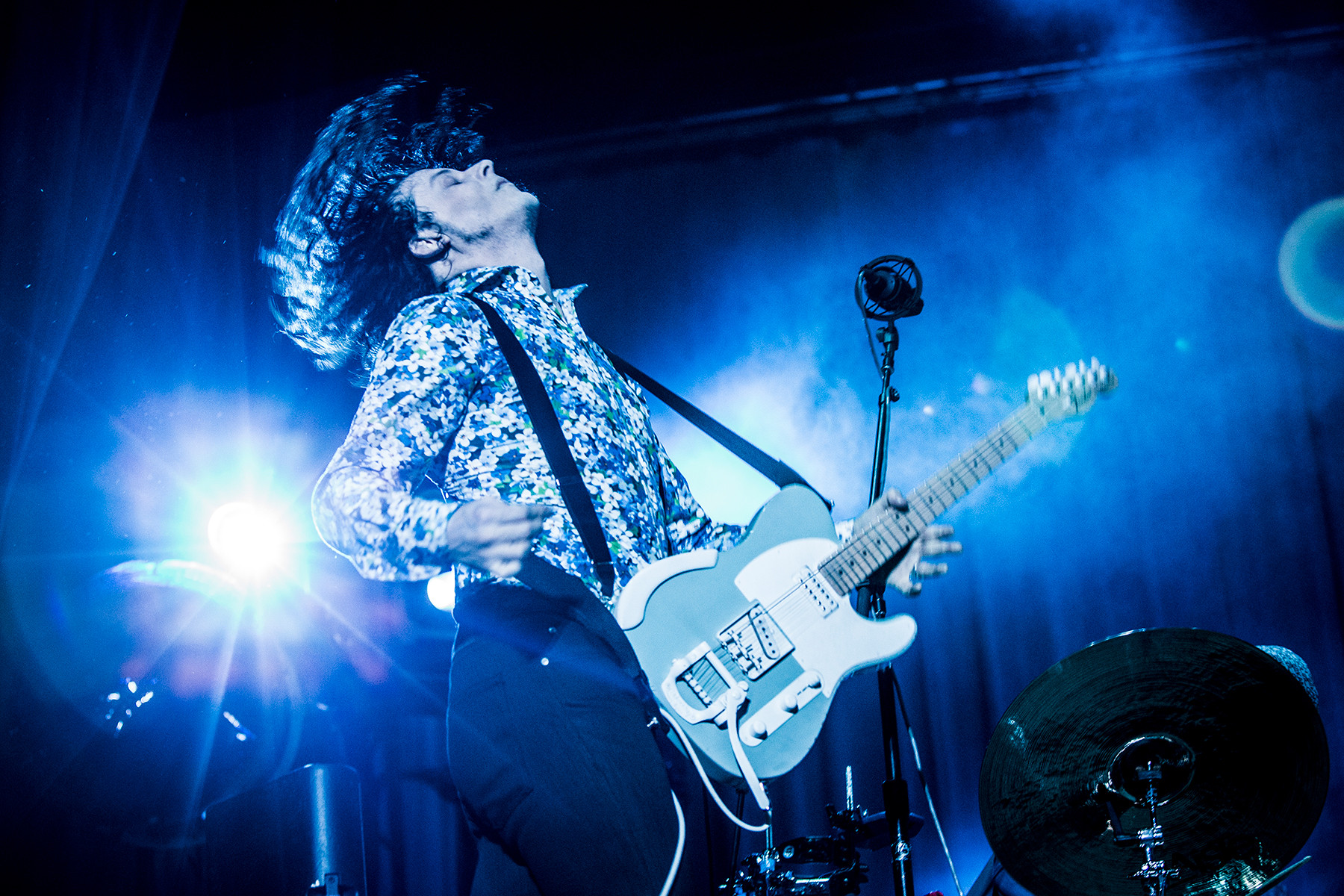 Jack White performing at Governors Ball in New York City, 2014.
Jack White performing at Governors Ball in New York City, 2014.
When The White Stripes gained prominence with albums like 2000’s De Stijl, mainstream guitar rock was often dominated by over-produced nu-metal and derivative grunge. Jack White and The White Stripes offered a refreshing alternative with their joyfully primitive garage-blues sound. “Fell in Love With a Girl” catapulted them to stardom, and Jack White delivered arguably the most recognizable rock riff of the 21st century with the raw, low-end stomp of “Seven Nation Army.” However, White has consistently avoided resting on past successes, evolving into a delightfully unpredictable sonic explorer. From the stoner funk and folk influences on his 2012 solo album Blunderbuss to the intensely over-the-top, fuzz-drenched drones of 2022’s Fear of the Dawn, he continuously challenges himself. For White, each time he picks up a guitar is a new adventure. “When I play a solo, it’s an attack — this is a fight, this is a struggle,” White told Rolling Stone in 2014. “I don’t care about virtuoso notes. If you stop me in the middle of a solo, I can’t say, ‘That’s an F-sharp, that’s a C.’” Jack White’s raw energy, blues-infused style, and constant sonic experimentation have made him a leading figure in contemporary rock guitar.
Key Tracks: “Seven Nation Army,” “Ball and Biscuit”
George Harrison
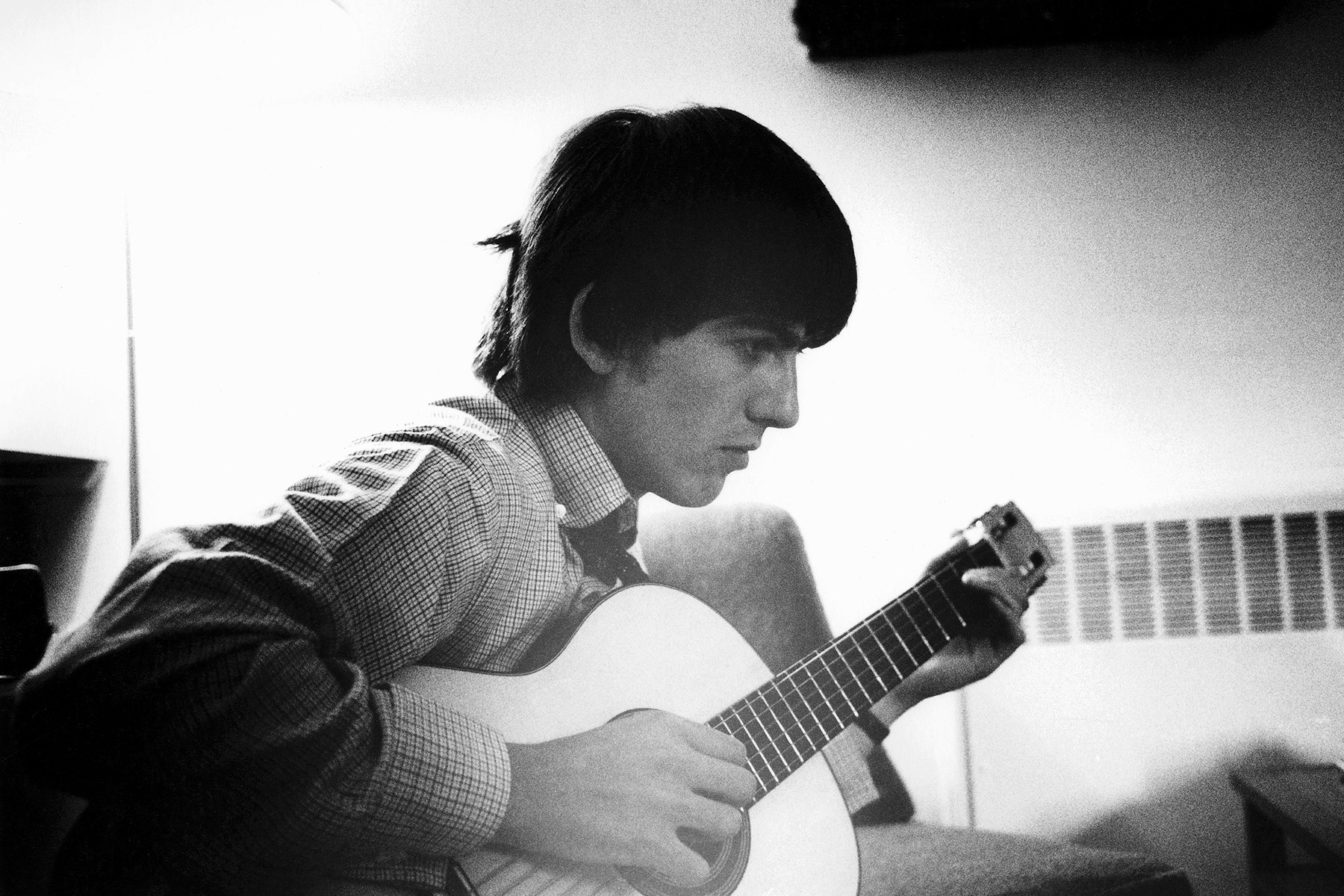 George Harrison of The Beatles playing acoustic guitar at Twickenham Film Studios.
George Harrison of The Beatles playing acoustic guitar at Twickenham Film Studios.
George Harrison redefined the role of the guitar in popular music with The Beatles. He didn’t just play lead guitar in a rock band; he defined the instrument’s central place in pop music. In Liverpool, he was the younger, dedicated guitarist who earned his place in the Beatles through diligent practice and skill. He drew inspiration from rockabilly heroes like Carl Perkins, evident in his energetic Cavern Club solo on “I Saw Her Standing There.” But Harrison continually pushed boundaries, experimenting with Indian-inspired drones on Rubber Soul, psychedelic textures on Revolver, and elegant arrangements on Abbey Road, always with a focus on serving the song. “Everyone else has played all the other bullshit,” Harrison famously said. “I just play what’s left.” His most profound guitar work came after the Beatles’ breakup, with his cosmic slide guitar on All Things Must Pass and Living in the Material World. Tom Petty described Harrison’s playing as a distinctive voice: “It really sounded like a voice, like a very distinct, signature voice that came out of him.” George Harrison’s innovative and melodic guitar style was integral to The Beatles’ sound and his solo work cemented his place as a guitar icon.
Key Tracks: “Something,” “Let It Be,” “Give Me Love”
Neil Young
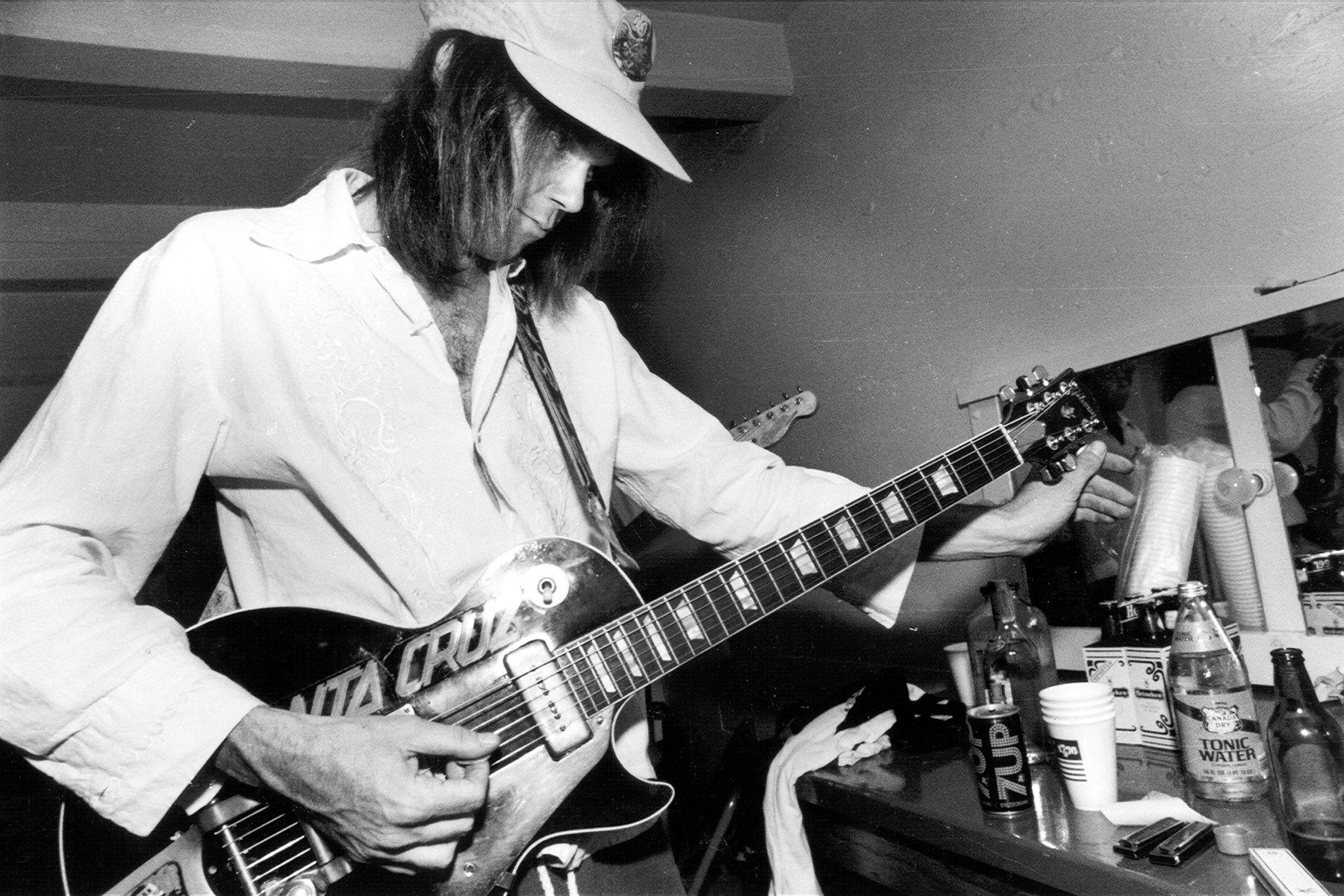 Neil Young circa 1970.
Neil Young circa 1970.
Long before his successful solo career, Neil Young honed his guitar skills in bands like the Squires, the Mynah Birds, Buffalo Springfield, and Crosby, Stills, Nash & Young. By the time Harvest was released, he was equally proficient on electric and acoustic guitar, seamlessly transitioning between gentle folk tunes like “The Needle and the Damage Done” and raw, proto-grunge tracks like “Down by the River” within a single performance. Trey Anastasio considers Young’s guitar work essential for study: “If I was ever going to teach a master class to young guitarists, the first thing I would play them is the first minute of Neil Young’s original ‘Down by the River’ solo.” While some purists have dismissed his style as “primitive” due to his use of repetition and seemingly simple solos, they often miss the emotional depth and raw power of his playing. “Nobody cares if you know how to play scales,” Young stated in 1992. “Nobody gives a shit if you have good technique or not. It’s whether you have feelings that you want to express with music, that’s what counts, really.” Neil Young’s emotionally resonant and uniquely expressive guitar style transcends technicality, making him a deeply influential and respected guitarist.
Key Tracks: “Cowgirl in the Sand,” “Powderfinger,” “Rockin’ in the Free World”
Eddie Hazel
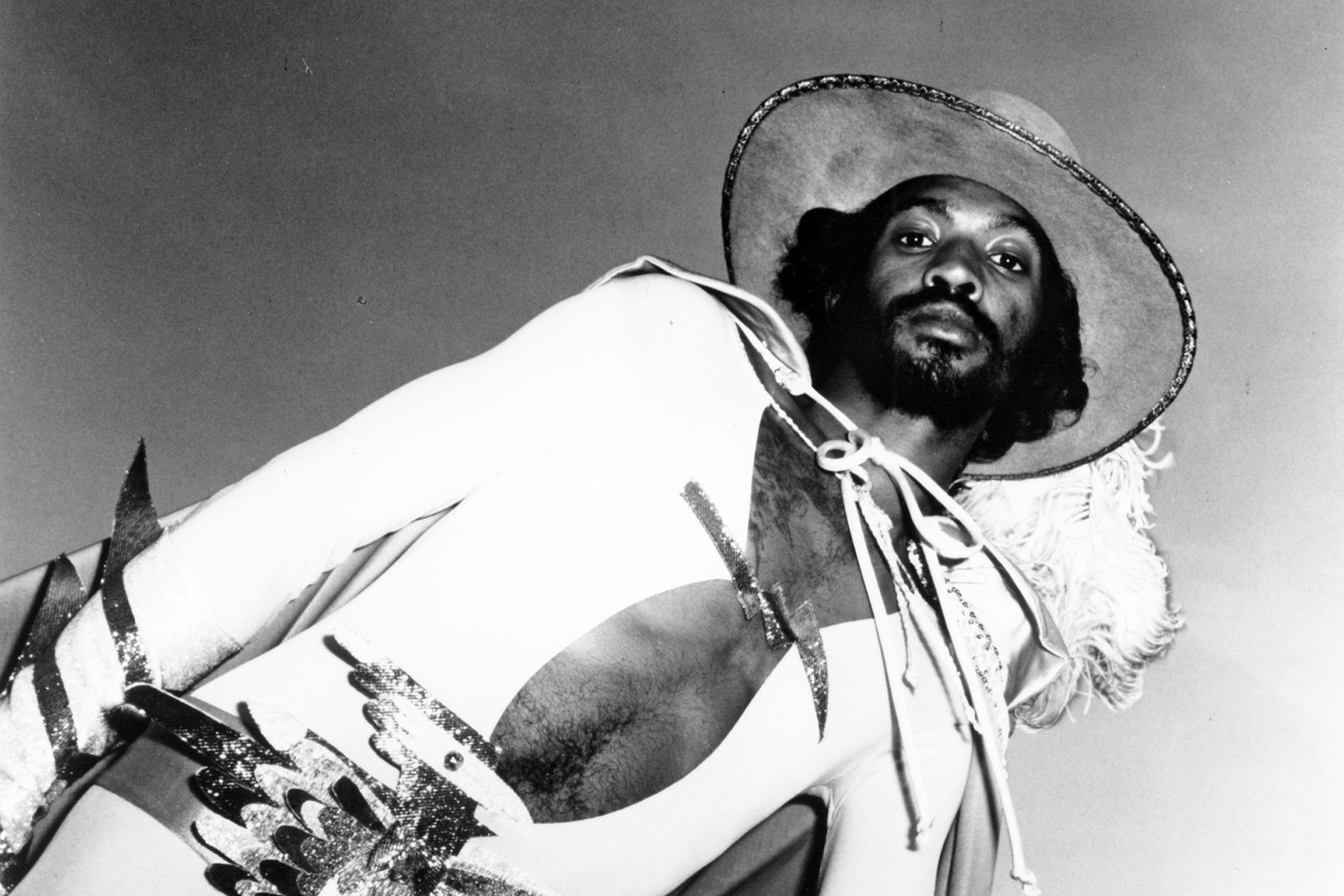 Eddie Hazel of Parliament in 1977.
Eddie Hazel of Parliament in 1977.
Legend surrounds “Maggot Brain,” the ten-minute guitar solo that instantly elevated the late Eddie Hazel to guitar legend status. Funkadelic bandleader George Clinton reportedly instructed Hazel, under the influence of LSD, to imagine his mother’s death and then her miraculous revival. Clinton recounted in his memoir: “I knew immediately that he understood what I meant. I could see the guitar notes stretching out like a silver web. When he played the solo back, I knew that it was good beyond good, not only a virtuoso display of musicianship but also an almost unprecedented moment of emotion in pop music.” Hazel’s broader work with P-Funk and his solo recordings showcase a thrilling fusion of groove-driven funk and soaring psychedelic guitar. “Maggot Brain,” however, remains his most influential piece, inspiring guitarists from Nels Cline and J. Mascis to Warren Haynes and Mike McCready, all of whom have performed it live, channeling Hazel’s profound musical spirit. Eddie Hazel’s emotionally charged and psychedelic guitar work left an indelible mark on funk, rock, and beyond.
Key Tracks: “Maggot Brain,” “Funky Dollar Bill”
David Gilmour
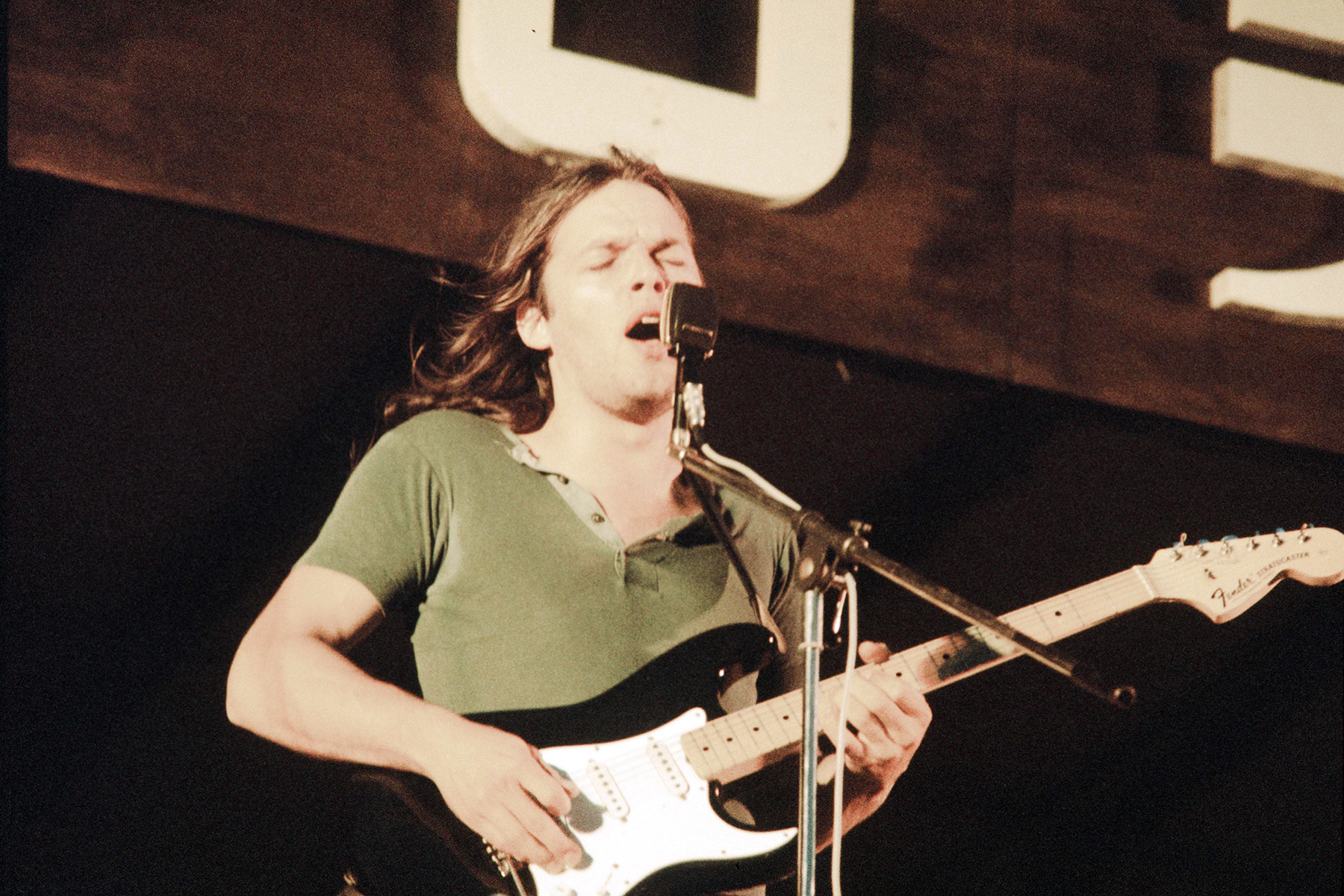 David Gilmour of Pink Floyd performing at Hakone Aphrodite, Japan in 1971.
David Gilmour of Pink Floyd performing at Hakone Aphrodite, Japan in 1971.
David Gilmour, Pink Floyd’s guitarist, songwriter, and producer, is known for crafting expansive, ethereal soundscapes. However, when he takes center stage for a guitar solo, a different energy emerges. “I wanted a bright, powerful lead guitar tone that would basically rip your face off,” he explained. Gilmour, a fiery blues-based soloist, paradoxically played in a band that rarely played traditional blues. His sprawling, melodic solos, elegant yet powerful, were sonic awakenings within Pink Floyd’s atmospheric compositions, most famously on The Dark Side of the Moon. Gilmour was also adept at avant-garde improvisation, showcased in Pink Floyd’s Live at Pompeii performances, and surprisingly funky rhythm guitar, from the slinky riff of “Have a Cigar” to the Chic-inspired flourishes in “Another Brick in the Wall, Part 2.” His pioneering use of echo and effects, initially inspired by Syd Barrett, culminated in his precise delay work on “Run Like Hell,” directly foreshadowing The Edge’s signature sound. David Gilmour’s versatile guitar work, blending blues roots with sonic innovation, is central to Pink Floyd’s iconic sound.
Key Tracks: “Comfortably Numb,” “Shine on You Crazy Diamond”
Buddy Guy
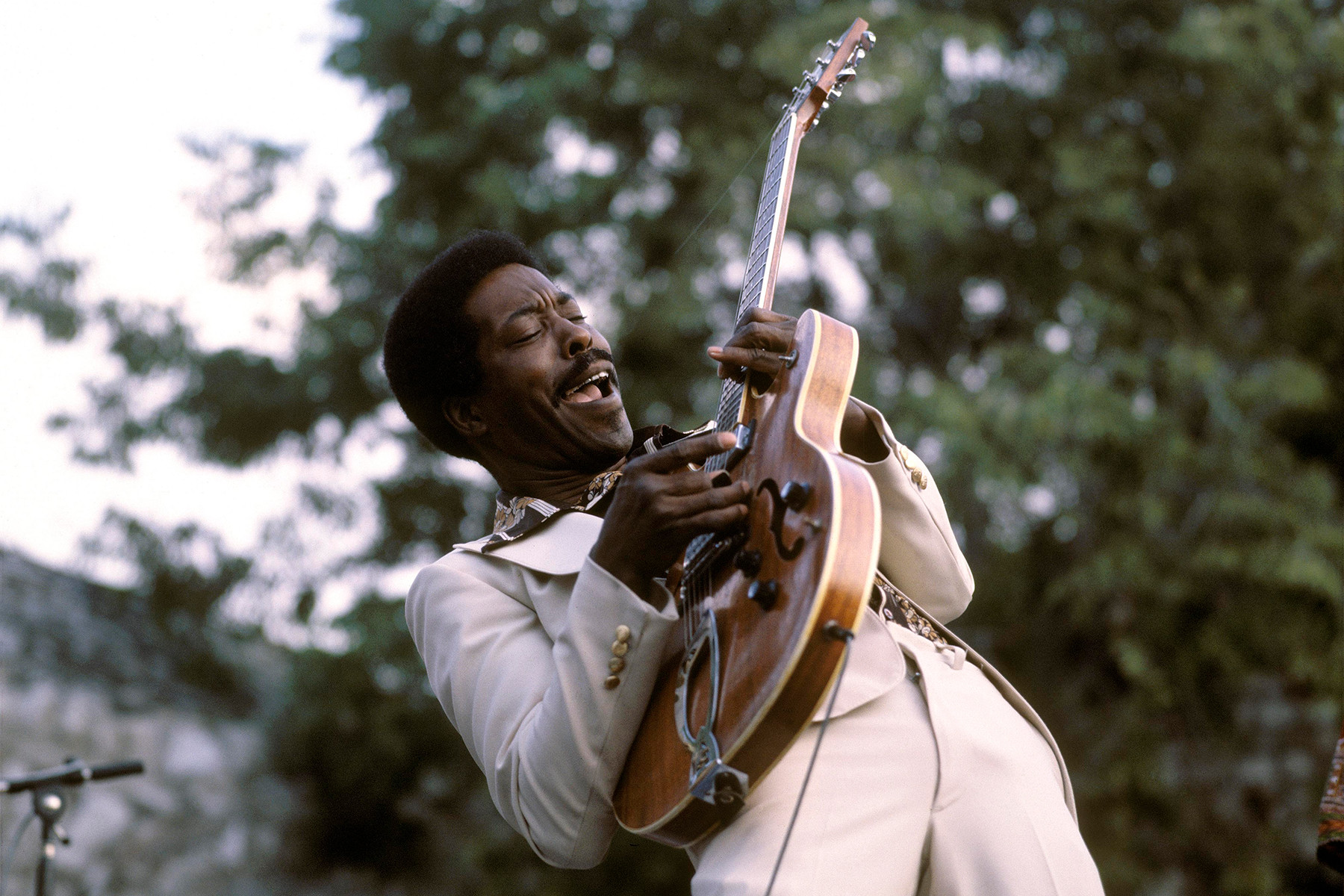 Buddy Guy performing at the Nice Jazz Festival in 1978.
Buddy Guy performing at the Nice Jazz Festival in 1978.
Buddy Guy recounts facing criticism for his guitar style, often described as “noise,” from his family in rural Louisiana to Chess Records executives Phil and Leonard Chess. He felt constrained on sessions with Muddy Waters, Howlin’ Wolf, and Little Walter, as he claims they “wouldn’t let me get loose like I wanted.” However, as a new generation of rock musicians discovered the blues, Guy’s electrifying fretwork became a major influence on guitarists from Jimi Hendrix to Jimmy Page. Guy’s flamboyant style—characterized by wide bends, prominent distortion, and frenetic licks—heard on classics like “Stone Crazy” and “First Time I Met the Blues,” and his collaborations with harmonica master Junior Wells, set a new benchmark for guitar intensity. His dynamic stage presence, including venturing into the audience mid-solo, remains captivating even at age 87. Eric Clapton, at Guy’s Rock & Roll Hall of Fame induction in 2005, stated: “He was for me what Elvis was probably like for other people. My course was set, and he was my pilot.” Buddy Guy’s passionate and flamboyant blues guitar style continues to inspire generations of musicians.
Key Tracks: “Stone Crazy,” “First Time I Met the Blues”
St. Vincent
 St. Vincent performing at The Fillmore Charlotte in 2018.
St. Vincent performing at The Fillmore Charlotte in 2018.
Annie Clark, known as St. Vincent, creates intricate and atmospheric music that, while not overtly guitar-centric, is profoundly shaped by her innovative approach to the instrument. Educated at Berklee College of Music and influenced by dexterous players like Robert Fripp, Adrian Belew, and Marc Ribot, the Grammy-winning artist layers her recordings with striking guitar tones, colors, voicings, harmonies, and effects. She prioritizes compositional impact over virtuosic display. “I don’t approach guitar like an ego thing — like, ‘I’m going to play faster than somebody else,’” Clark explained to Premier Guitar in 2011. “I’m not that interested in that athletic aspect. That’s the difference between being an athlete and being an artist, and it’s great when those things can combine. That’s the ideal — to make something that’s musically viable also emotionally compelling. That’s the happy medium.” St. Vincent’s sophisticated and textural guitar work, focused on emotional impact and sonic innovation, makes her a unique and influential contemporary guitarist.
Key Tracks: “Rattlesnake,” “Cruel,” “Masseduction”
John Frusciante
 John Frusciante of Red Hot Chili Peppers in concert in 2007.
John Frusciante of Red Hot Chili Peppers in concert in 2007.
The Red Hot Chili Peppers have always defied easy categorization, a testament in large part to John Frusciante, son of a Juilliard-trained pianist. Replacing the band’s original guitarist, the late Hillel Slovak, was a daunting task, but Frusciante, now in his third tenure with the band, played a pivotal role in expanding the Chili Peppers’ musical palette beyond their initial funk-rock origins. Always prioritizing the song, Frusciante brought a new breadth to the Chili Peppers’ sound. Consider the heavy riffing in their cover of Stevie Wonder’s “Higher Ground,” the delicate strumming of “Under the Bridge” and “Scar Tissue,” the gritty funk of “Give It Away,” the introspective mood of “Breaking the Girl,” and the volcanic, Hendrix-inspired solo of “Dani California.” This eclectic range elevated Chili Peppers albums like Californication and Blood Sugar Sex Magik, making Frusciante one of the most vital and influential guitarists of the alternative rock era. John Frusciante’s versatile and song-centric guitar style was crucial in shaping the Red Hot Chili Peppers’ evolution and enduring success.
Key Tracks: “Dani California,” “Under the Bridge”
James Burton
 James Burton performing live in Amsterdam in 1975.
James Burton performing live in Amsterdam in 1975.
James Burton’s signature “chicken pickin'” style – bright, crisp, and concise – is a defining sound in country music and a significant influence on rock guitar. Burton began his career at 14, writing “Susie Q” for Dale Hawkins, and became a teen idol when he joined Ricky Nelson’s band in 1957. With Nelson, Burton developed his distinctive technique: using a fingerpick and a flat pick, and replacing the top four strings on his Telecaster with banjo strings, creating a snappy, popping, stuttering guitar sound. Keith Richards famously declared, “I never bought a Ricky Nelson record. I bought a James Burton record.” In the late 1960s and 70s, he led Elvis Presley’s TCB Band and became a sought-after session guitarist on country-influenced records by Joni Mitchell and Gram Parsons. Joe Walsh recognized his widespread presence: “He was just a mysterious guy: ‘Who is this guy and why is he on all these records I like?’ His technique was all important.” James Burton’s innovative “chicken pickin'” technique and versatile playing have made him a foundational figure in country and rock guitar.
Key Tracks: “Hello Mary Lou,””Susie Q,” “Believe What You Say”
James Hetfield and Kirk Hammett
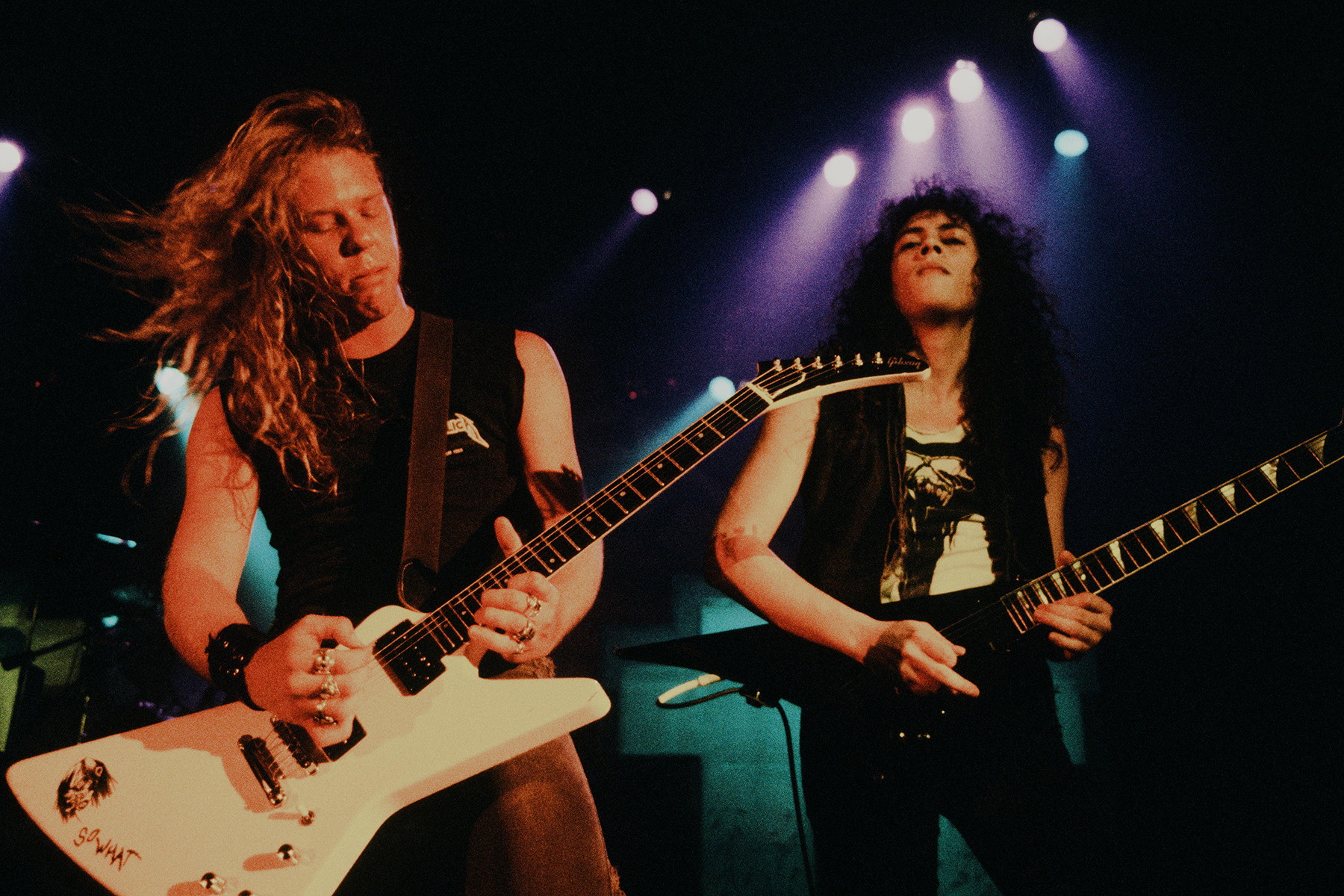 James Hetfield and Kirk Hammett of Metallica live in Tokyo in 1986.
James Hetfield and Kirk Hammett of Metallica live in Tokyo in 1986.
Metallica exploded onto the music scene with a furious speed and intensity. Singer and rhythm guitarist James Hetfield unleashed whiplash-inducing riffs at breakneck tempos, reminiscent of Black Sabbath played at double speed. Lead guitarist Kirk Hammett added chaotic, high-speed solos. Hetfield, along with Hammett’s predecessor Dave Mustaine (a guitar hero in his own right with Megadeth), developed techniques to minimize finger movement for maximum speed, redefining metal guitar on tracks like “Phantom Lord” and “Jump in the Fire.” However, by Metallica’s second album, with Hammett, a former student of Joe Satriani, incorporating soulful melody into songs like “Fade to Black” and “The Call of Ktulu,” the band achieved a unique balance. This duality—Hetfield’s crushing rhythm guitar and Hammett’s emotive, wah-driven leads—became Metallica’s signature, defining their biggest hits: “Enter Sandman,” “One,” “Master of Puppets,” songs that capture both the band’s aggression and their melodic sensibility. The guitar partnership of James Hetfield and Kirk Hammett is central to Metallica’s sound and their impact on heavy metal.
Key Tracks: “One,” “Fade to Black,” “Sad But True”
Albert King
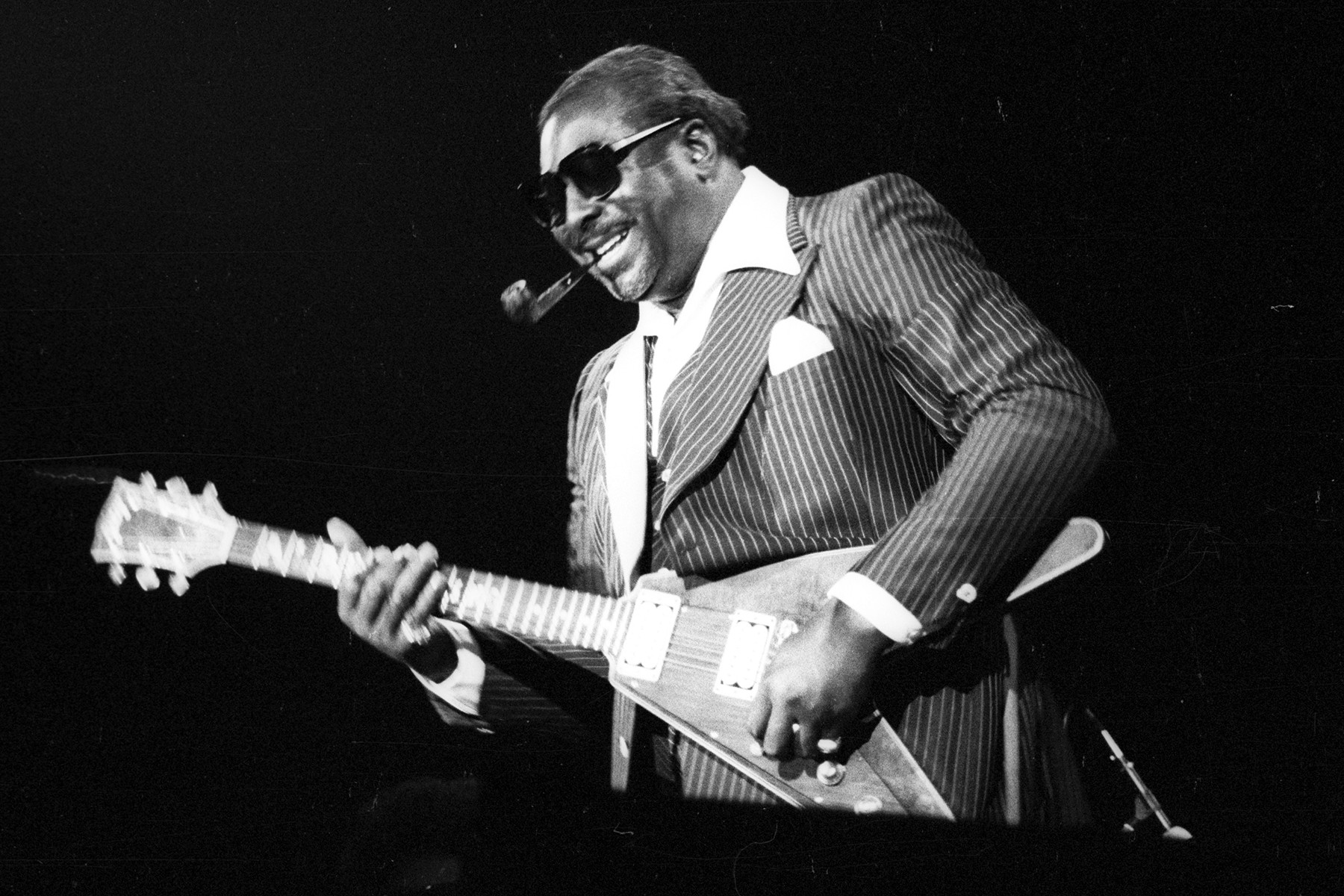 Albert King circa 1970.
Albert King circa 1970.
When Rolling Stone interviewed Albert King in 1968 about his guitar influences, he replied, “Nobody. Everything I do is wrong.” A pioneer of electric blues, King (left-handed) played a right-handed 1959 Gibson Flying V upside down, with the bass strings facing downwards. He used a unique, secret tuning and played with his thumb, not a pick. The imposing six-foot-four, 300-pound King could bend notes further and with more power than almost any other guitarist. His recordings profoundly influenced a generation: Eric Clapton borrowed the “Strange Brew” solo from King, and Duane Allman transformed the melody of King’s “As the Years Go Passing By” into the main riff of “Layla.” Jimi Hendrix was awestruck when King opened for him at the Fillmore in 1967. “I taught [Hendrix] a lesson about the blues,” King claimed. “I could have easily played his songs, but he couldn’t play mine.” Albert King’s powerful bending technique, unique playing style, and influential recordings cemented his status as a blues guitar icon.
Key Tracks: “Born Under a Bad Sign,” “As the Years Go Passing By”
Randy Rhoads
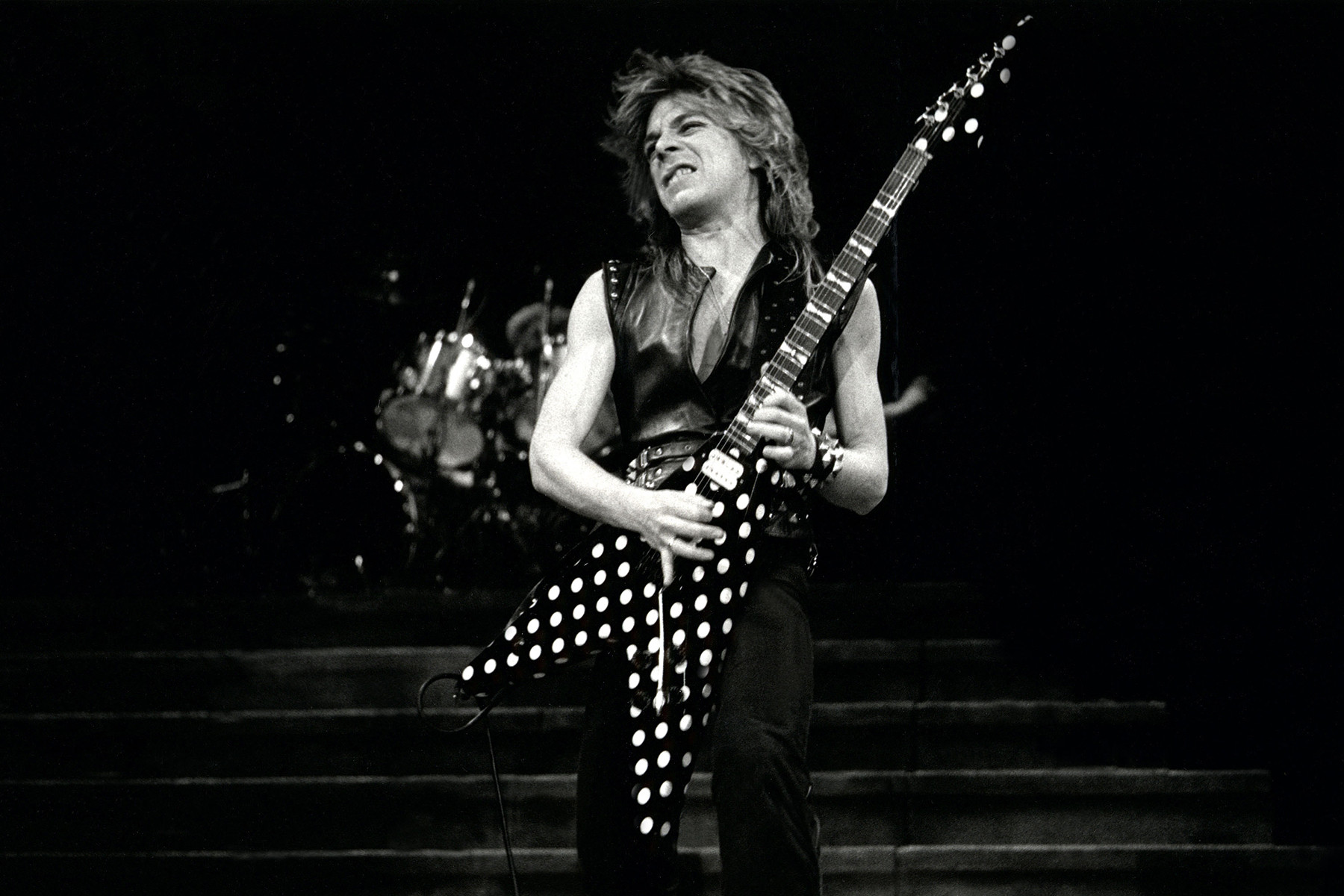 Randy Rhoads performing in Chicago in 1982.
Randy Rhoads performing in Chicago in 1982.
Randy Rhoads’ career was tragically short, ending with his death in a plane accident in 1982 at age 25. Yet, his precise, architectural, and lightning-fast solos on Ozzy Osbourne’s “Crazy Train” and “Mr. Crowley” established a template for metal guitar soloing that continues to resonate. Tom Morello declared, “I practiced eight hours a day because of him,” calling Rhoads “the greatest hard-rock/heavy-metal guitar player of all time.” Rhoads co-founded Quiet Riot as a teenager and joined Osbourne’s Blizzard of Ozz band in 1979 after teaching guitar for several years. Legend has it that Rhoads continued to take guitar lessons in different cities while touring with Ozzy. By his final album, Osbourne’s Diary of a Madman, Rhoads was delving deeper into classical music and exploring jazz. Nikki Sixx of Mötley Crüe observed that Rhoads “was reaching deep into himself as a guitar player. That was really the next step right there.” Randy Rhoads’ virtuosity, classical influences, and innovative metal guitar style left an enduring legacy despite his brief career.
Key Tracks: “Crazy Train,” “Mr. Crowley,” “Diary of a Madman”
Stevie Ray Vaughan
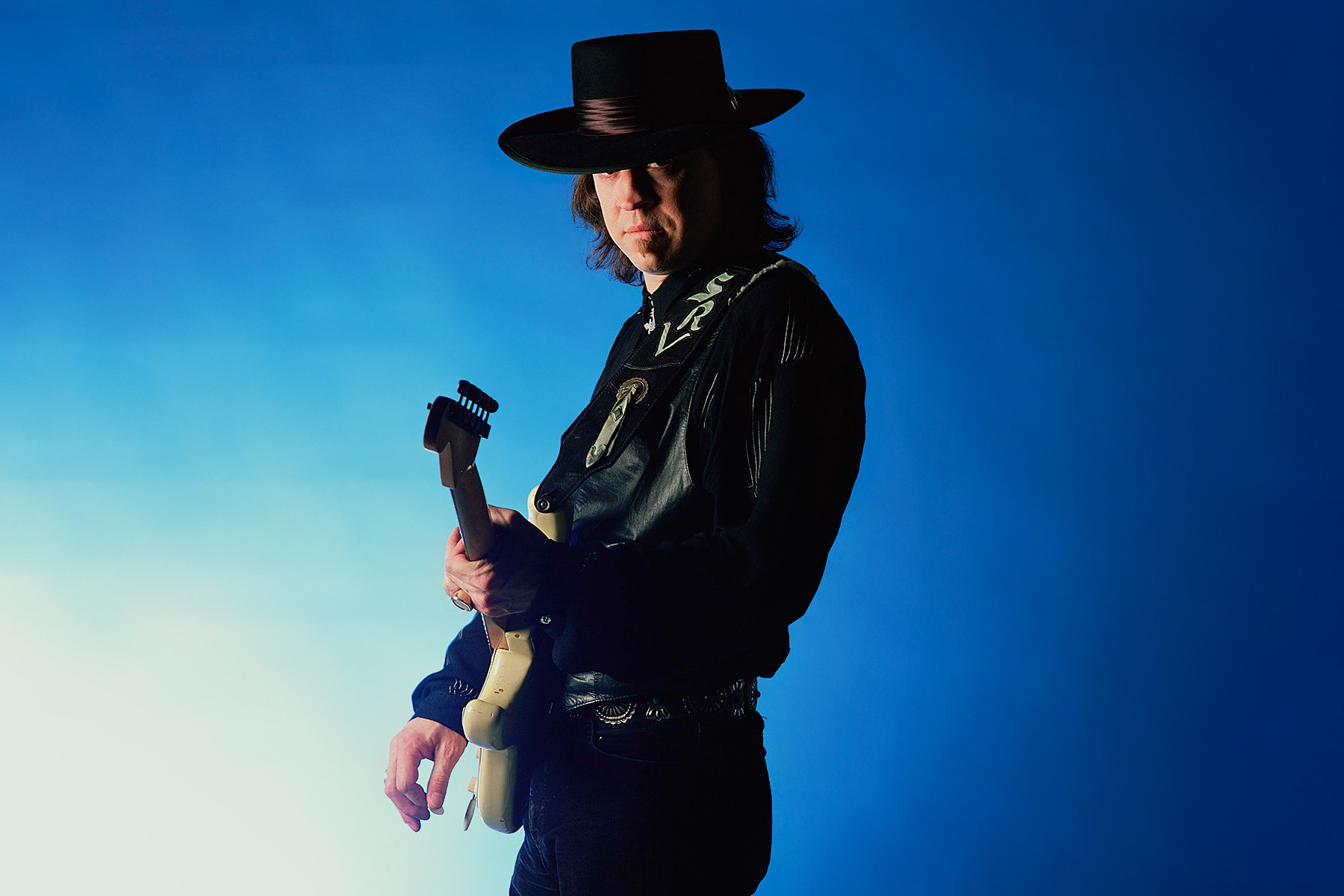 Stevie Ray Vaughan in the United States.
Stevie Ray Vaughan in the United States.
In the early 1980s, amidst the rise of MTV, blues guitar was far from mainstream. However, Stevie Ray Vaughan from Texas commanded attention. He absorbed the styles of virtually every great blues guitarist, plus Jimi Hendrix, jazz, and rockabilly. His massive tone, effortless virtuosity, and impeccable swing transformed blues shuffles like “Pride and Joy” into hard-hitting anthems. Vaughan was recognized as an equal by blues legends like B.B. King and rock icons like Eric Clapton. Despite his tragic death in a 1990 helicopter crash, he continues to inspire guitarists across generations, from Pearl Jam’s Mike McCready to John Mayer and Gary Clark Jr. Clark Jr. stated, “Stevie was one of the reasons I wanted a Stratocaster — his tone, which I’ve never been able to get down, was just so big and bold and bright at the same time. If you listen to his records and watch his videos, you can tell he’s just giving you everything he had. His passion is overwhelming.” Stevie Ray Vaughan’s passionate blues playing, virtuosity, and powerful tone revived blues guitar for a new generation.
Key Tracks: “Love Struck Baby,” “Cold Shot”
Freddy King
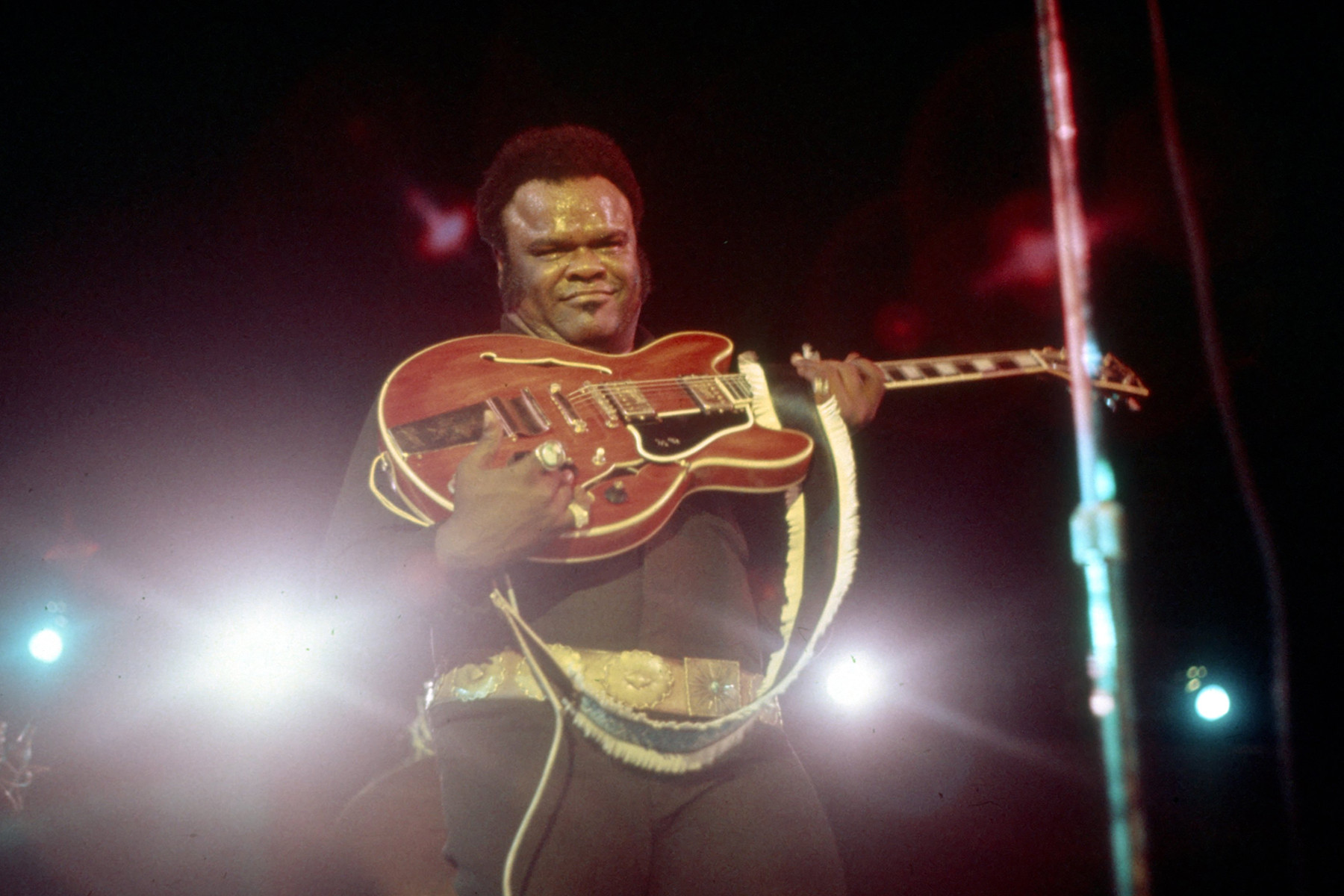 Freddy King circa 1973.
Freddy King circa 1973.
In a 1985 interview, Eric Clapton cited Freddy King’s 1961 B-side “I Love the Woman” as “the first time I heard that electric lead-guitar style, with the bent notes … [it] started me on my path.” Clapton shared his admiration for King with fellow British guitar heroes Peter Green, Jeff Beck, and Mick Taylor, all profoundly influenced by King’s sharp, treble-heavy tone and concise melodic hooks on iconic singles like “The Stumble,” “I’m Tore Down,” and “Someday, After Awhile.” Nicknamed “The Texas Cannonball” for his imposing physique and electrifying live shows, King possessed a unique guitar attack. Derek Trucks emphasizes the distinctiveness of King’s technique: “Steel on steel is an unforgettable sound,” referring to King’s use of metal banjo picks. “But it’s gotta be in the right hands. The way he used it — man, you were going to hear that guitar.” Trucks still hears King’s profound influence on Clapton: “When I played with Eric,” Trucks recently said, “there were times when he would take solos, and I would get that Freddy vibe.” Freddy King’s sharp tone, melodic phrasing, and use of metal picks left a lasting impact on blues and rock guitar.
Key Tracks: “Hide Away,” “The Stumble”
Tom Morello
 Tom Morello of Prophets of Rage performing in New York City.
Tom Morello of Prophets of Rage performing in New York City.
With few exceptions, notably Jimi Hendrix, rock guitars for decades largely maintained a recognizable “rock guitar” sound. Then came Rage Against the Machine and their guitar innovator, Tom Morello. Just as Zack de la Rocha’s lyrics boldly injected politics into the music, Morello revolutionized guitar sounds, pushing sonic boundaries. The turntable scratching on “Bulls on Parade” from Evil Empire? The alien video game sounds on “Killing in the Name” or the dive-bomber effect on “Fistful of Steel,” both from Rage’s debut album? All created by Morello using only guitars, effects pedals, and his boundless imagination. Morello’s blend of effects and thunderous chords evoked heroes like the Stooges’ Ron Asheton (evident in Rage’s “Sleep Now in the Fire”), but Morello added an even more amplified and audacious approach. While his projects since Rage Against the Machine, such as Nightwatchman and Street Sweeper Social Club, are comparatively more restrained, Morello’s revolutionary approach to guitar effects and sonic textures has permanently impacted the instrument.
Key Tracks: “Guerrilla Radio,” “Killing in the Name”
Mother Maybelle Carter
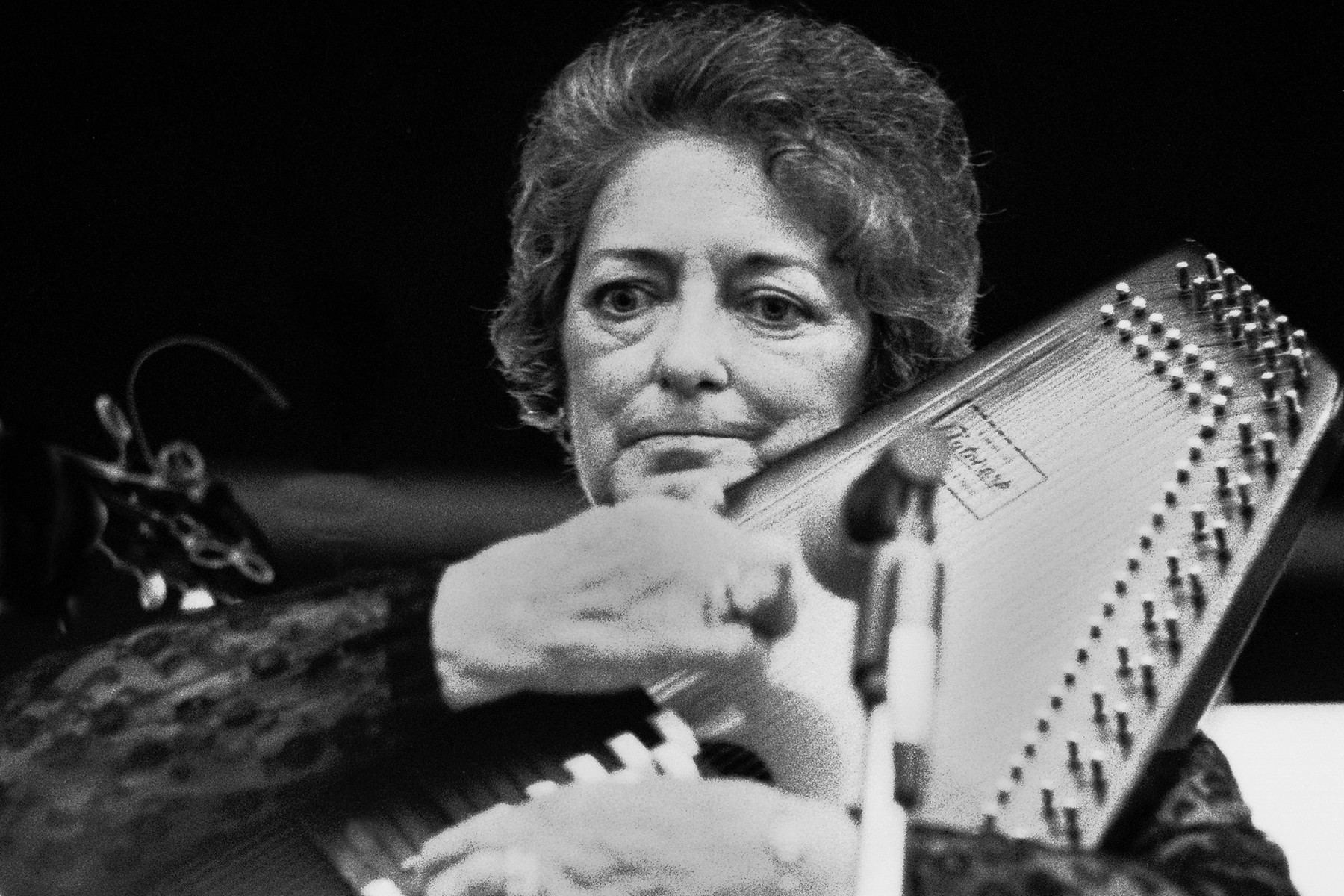 Maybelle Carter performing at the A.P. Carter Memorial Festival in Virginia, 1977.
Maybelle Carter performing at the A.P. Carter Memorial Festival in Virginia, 1977.
Maybelle Carter did not originate her signature guitar style—known as “the Carter Scratch”—in isolation. She credited roots pioneer Lesley Riddle with teaching her the distinctive fingerpicking technique. However, through a series of singles with the Carter Family, she popularized this style globally on songs like “Will the Circle Be Unbroken,” “Wildwood Flower,” and “Bury Me Under the Weeping Willow.” Carter’s playing, beginning at age 13, transformed the guitar from a purely rhythmic instrument to one capable of playing melody, rhythm, and bass simultaneously. Singer-songwriter Courtney Marie Andrews, a disciple among thousands, called her “perhaps the most emulated guitar player of all time” in 2019. Carter herself explained her style’s origin: “When I started playing, I didn’t have nobody to play with me, so that’s how I developed this style.” Mother Maybelle Carter’s innovative fingerpicking style, the “Carter Scratch,” revolutionized country guitar and influenced countless musicians.
Key Tracks: “Wildwood Flower,” “Bury Me Under the Weeping Willow”
Robert Johnson
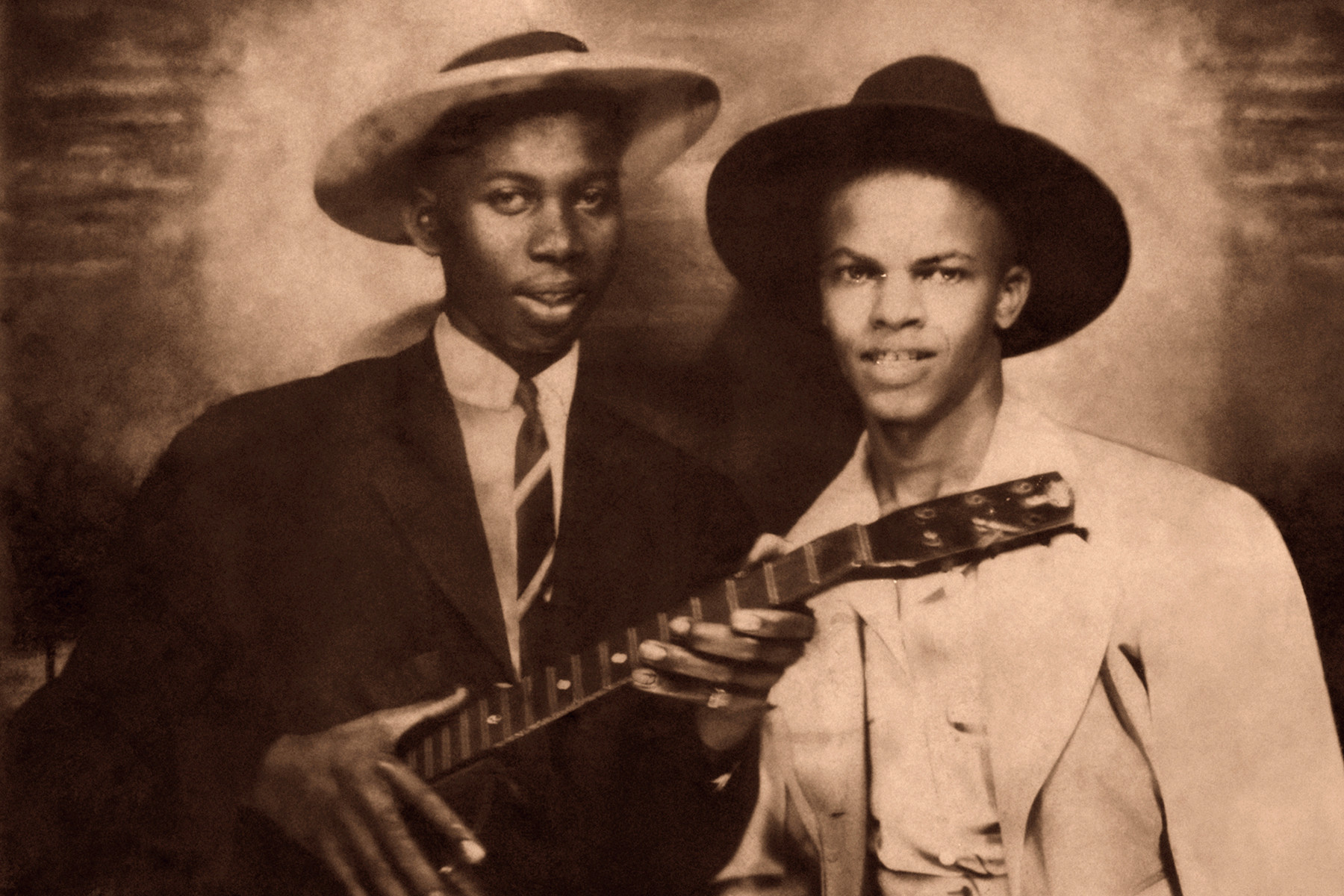 Robert Johnson with Johnny Shines, circa 1935.
Robert Johnson with Johnny Shines, circa 1935.
Robert Johnson remained largely unknown for decades after his death in 1938. Yet, the 29 songs he recorded in 1936 and 1937—including classics like “Cross Road Blues,” “Love in Vain,” and “Traveling Riverside Blues”—became sacred texts for rock guitarists from Clapton to Dylan. They were captivated by his ability to make a single guitar sound like a full ensemble—fingerpicking, slide, and rhythm parts intertwining and conversing, riffs emerging and receding like specters. Cream, The Rolling Stones, Led Zeppelin, and The White Stripes, among countless others, covered his songs. Bob Dylan, in Chronicles, vividly recalled hearing Johnson’s King of the Delta Blues Singers for the first time: “From the first note the vibrations from the loudspeaker made my hair stand up. The stabbing sounds from the guitar could almost break a window.” Robert Johnson’s haunting vocals and virtuosic, ensemble-like guitar playing laid the foundation for blues and rock guitar.
Key Tracks: “Ramblin’ on My Mind,” “Traveling Riverside Blues”
Keith Richards
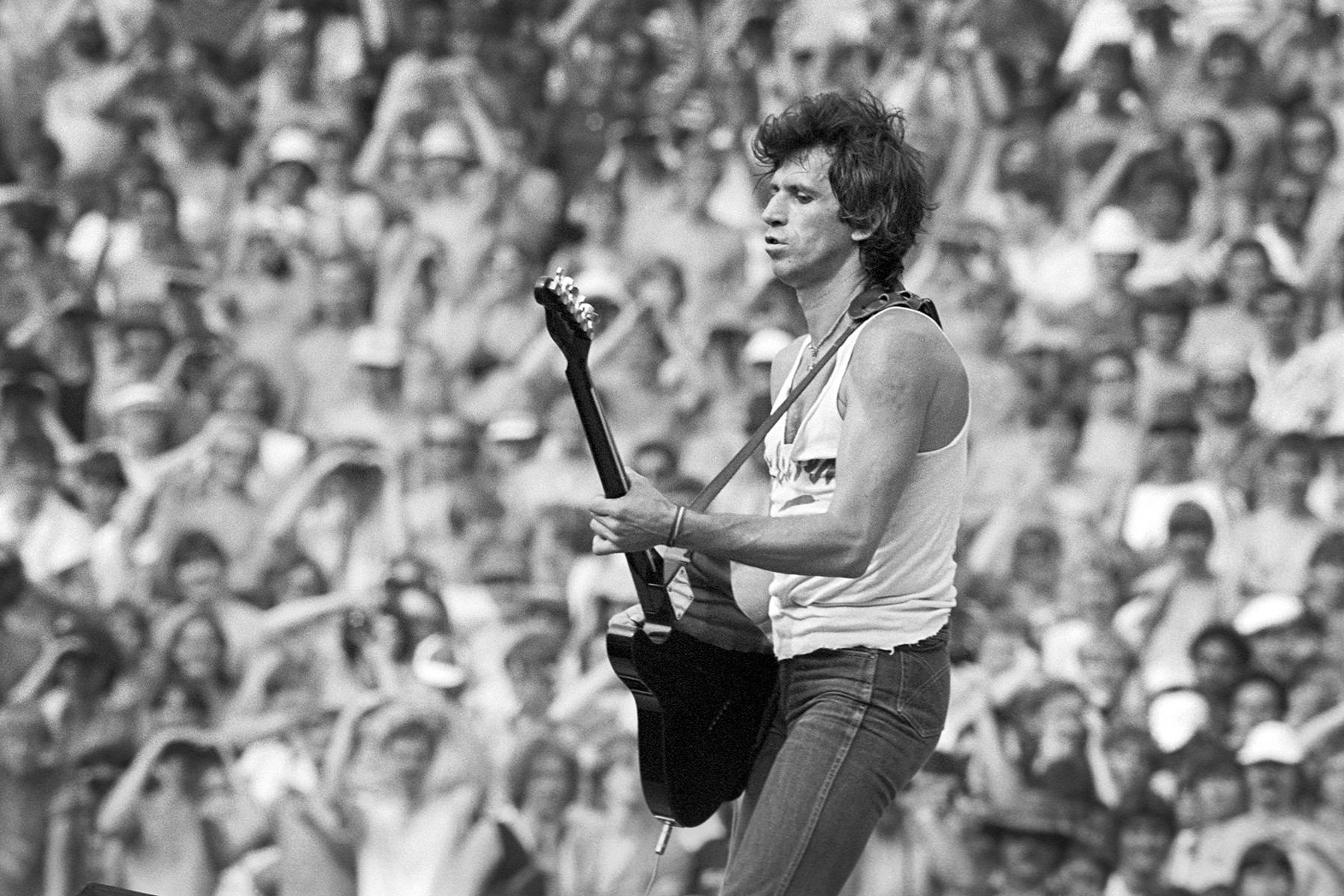 Keith Richards of The Rolling Stones during the Tattoo You Tour, 1982.
Keith Richards of The Rolling Stones during the Tattoo You Tour, 1982.
Keith Richards has always made guitar playing seem effortless. The power of his iconic riffs—”(I Can’t Get No) Satisfaction,” “Start Me Up,” “Brown Sugar”—lies in the raw simplicity of his technique, the symmetry of the notes, and his innate sense of swing. In the 1960s, his rock-solid rhythm guitar anchored Brian Jones’s more experimental musical ideas, whether Jones played slide guitar or marimba on tracks like “Time Is on My Side,” “Paint It, Black,” and “Under My Thumb.” In the 1970s, with Mick Taylor on lead guitar, Richards provided lush, grooving backdrops for tracks like “Tumbling Dice,” “Can’t You Hear Me Knocking,” and “Wild Horses.” His acoustic playing is equally adept in blues (“Love in Vain”) and ballads (“Angie”). Since Ron Wood joined, Richards has become part of a musical yin and yang, weaving guitar parts with Wood, seamlessly shifting between riffs and solos. “[A great riff] just appears at your fingertips and is coming out of the instrument,” he told Rolling Stone in 2020. “And that is a great riff, totally unthought about, unstructured, no rules, no nothing. It’s just, one minute it ain’t there, and the next minute, there it is.” Keith Richards’ iconic riffs, effortless swing, and essential role in The Rolling Stones’ sound have made him a rock and roll legend.
Key Tracks: “(I Can’t Get No) Satisfaction,” “Gimme Shelter”
Prince
 Prince performing at the Fabulous Forum, Inglewood, CA in 1985.
Prince performing at the Fabulous Forum, Inglewood, CA in 1985.
Prince delivered arguably the greatest power-ballad guitar solo in history with “Purple Rain.” He could funk with the precision of Jimmy Nolen and Nile Rodgers, or wail like Eddie Van Halen. Like Bo Diddley, he reimagined the guitar’s form itself—first with his yellow “cloud guitar” in the mid-1980s, then his phallic “symbol guitar.” While often compared to Jimi Hendrix, Prince saw his influences differently: “It’s only because he’s Black. That’s really the only thing we have in common,” he told Rolling Stone. “If they really listened to my stuff, they’d hear more of a Santana influence than Jimi Hendrix. Hendrix played more blues, Santana played prettier.” He even joked about an unexpected benefit of being a guitar god: “Playing electric guitar your whole life does something to you. I’m convinced all that electricity racing through my body made me keep my hair.” Prince’s unparalleled versatility, virtuosity, and iconic guitar solos established him as a true guitar legend.
Key Tracks: “Purple Rain,” “When Doves Cry”
Tony Iommi
 Tony Iommi of Black Sabbath performing in London, 1976.
Tony Iommi of Black Sabbath performing in London, 1976.
Tony Iommi, co-founder of Black Sabbath, is a pillar of heavy metal guitar. His signature doomy style arose from an industrial accident that severed the tips of his middle and ring fingers on his fretting hand. Despite this, he adapted, using plastic finger caps, lighter gauge strings, and a more forceful grip to play again. Combined with heavily distorted Laney amplifiers boosted by a modified Dallas Rangemaster treble booster, this necessity-driven style created an unusually dark and menacing sound. By tuning his guitars down several steps for easier bending, Iommi established the earth-shattering template for countless metal guitarists. “In them days, you had to make your sound,” Iommi told Guitar World in 2020. “You couldn’t buy a gadget that made whatever sound you wanted, you had to put the hard yards in and build a tone yourself. And I felt that was great, really, because you believe in it more when you’ve made it all yourself.” Tony Iommi’s innovative, accident-inspired playing style and heavy, downtuned riffs defined the sound of heavy metal guitar.
Key Tracks: “Sabbath Bloody Sabbath,” “Symptom of the Universe”
Jimmy Nolen
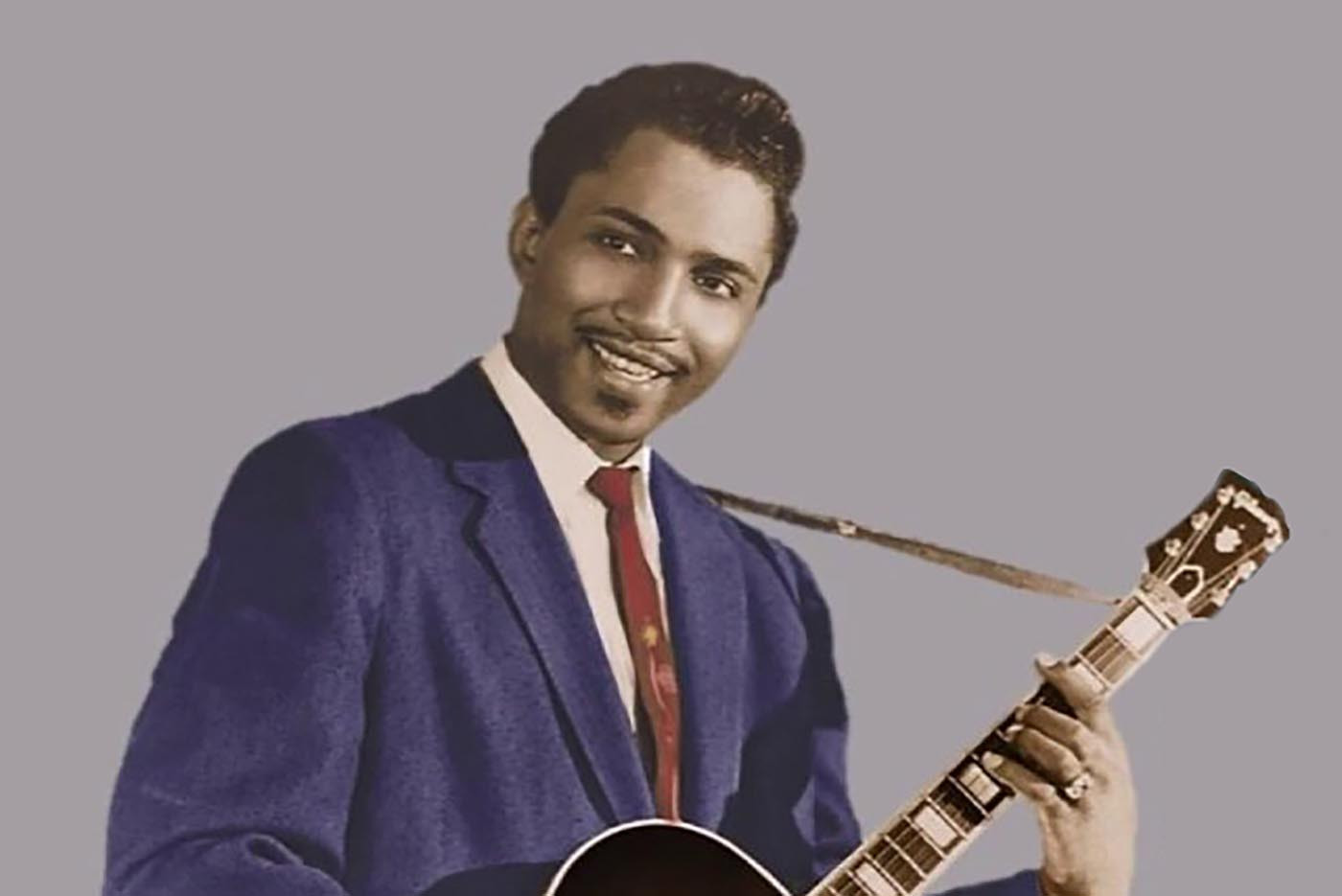 Jimmy Nolen performing.
Jimmy Nolen performing.
Years before joining James Brown’s band, guitarist Jimmy Nolen developed a rhythmic approach to compensate for lackluster drummers: “I used to just try to play and keep my rhythm going as much like a drum as I possibly could,” he explained. “It kind of keeps the drummer straight.” When Nolen joined James Brown in early 1965, his bright, forward-driving rhythm guitar and Brown’s explosive rhythmic vision fused perfectly. While real life was less harmonious—Nolen passed away in 1983, concerned about Brown’s demanding work ethic—the musical results are undeniable. Beginning with the 1965 landmark “Papa’s Got a Brand New Bag”—whose iconic intro is Nolen’s—and continuing for a triumphant half-decade through classics like “Let Yourself Go,” “Cold Sweat,” and “Funky Drummer,” Nolen defined funk (and R&B) guitar. His style is characterized by fearsomely choppy rhythm, precise, needling lead lines, both central and peripheral to the musical action. Jimmy Nolen’s choppy, percussive funk guitar style was essential to James Brown’s groundbreaking sound and defined funk guitar.
Key Tracks: James Brown’s “Papa’s Got a Brand New Bag” and “Cold Sweat”
Carlos Santana
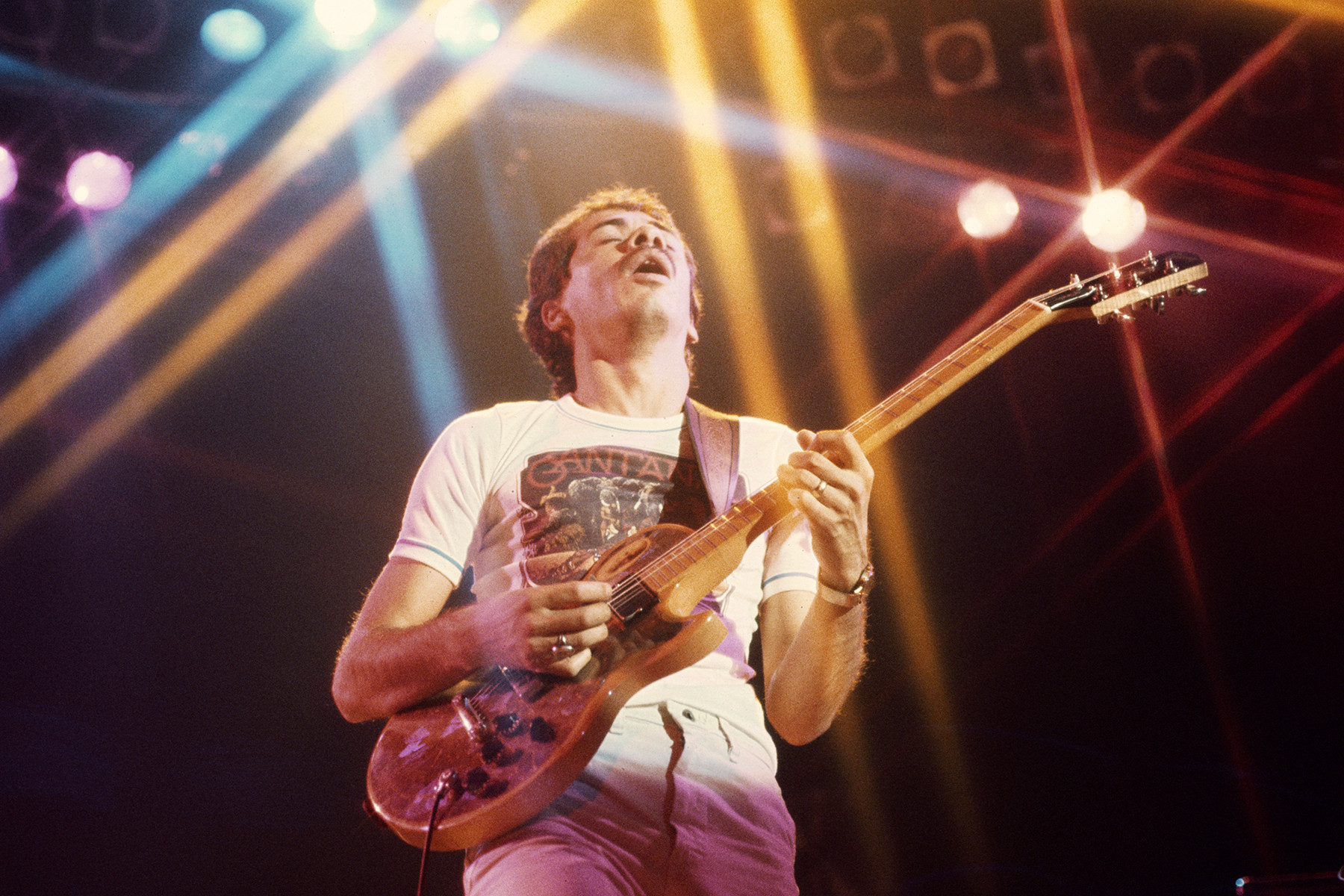 Carlos Santana performing in 1975.
Carlos Santana performing in 1975.
Carlos Santana’s pioneering fusion of blues, jazz, and Latin music burst onto the world stage with a show-stopping performance at Woodstock. This fusion remained potent decades later, when Supernatural sold 15 million copies and won nine Grammys. Throughout his career, Santana remained true to his unique musical vision, conjuring transcendent melodies rooted in both his barrio upbringing and a spiritual, astral plane. Henry Garza of Los Lonely Boys noted, “His music was something new, but it was intertwined with everything else that was out there at the time. He incorporated his culture into the music.” Like Miles Davis and B.B. King, Santana is instantly identifiable in a single note. He aimed to emulate jazz heroes like Wes Montgomery and Grant Green, but realized, “as hard as I tried, I couldn’t — I always sounded like me.” Conversely, no one can replicate Santana’s exquisite, crystalline guitar tone, but his global influence is undeniable. Prince cited him as a greater influence than Jimi Hendrix, stating simply that “Santana played prettier.” Carlos Santana’s fusion of Latin rhythms with blues and rock, coupled with his signature tone and melodic phrasing, has made him a global guitar icon.
Key Tracks: “Black Magic Woman,” “Oye Como Va,” “Soul Sacrifice”
Duane Allman
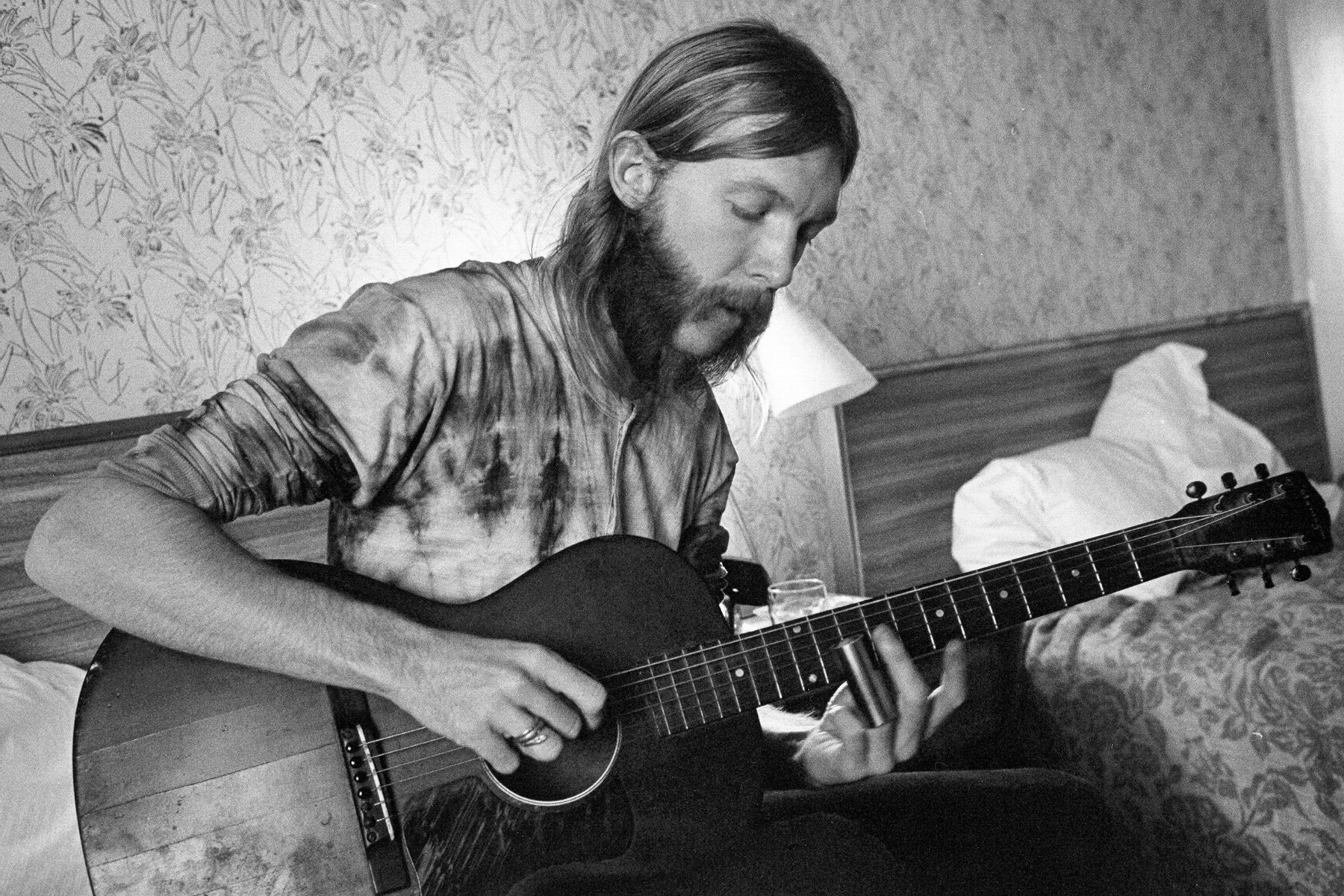 Duane Allman using a steel slide on an acoustic guitar in 1971.
Duane Allman using a steel slide on an acoustic guitar in 1971.
Duane Allman’s life was tragically short, ending in a 1971 motorcycle accident at age 24. Yet, he packed a visionary guitar career into those years. With the Allman Brothers Band, he explored the breadth of American music: modal jazz, blues, country, and psychedelic Southern rock. As a teenager in Florida, he learned his Gibson Les Paul by playing along to Robert Johnson and Chuck Berry records. He initially made his name as a session musician, notably on Muscle Shoals soul sessions with Wilson Pickett and Aretha Franklin. He formed the ABB in 1969 with his brother Gregg. At their first jam, Duane declared, “Anybody who doesn’t want to be in my band is going to have to fight his way out the door.”
His defining statement was At Fillmore East, improvising under the influence of John Coltrane and Miles Davis, from the bottleneck slide of “Statesboro Blues” to the 19-minute jam “You Don’t Love Me.” Duane also contributed to Derek and the Dominos’ Layla sessions, spontaneously creating history with Eric Clapton, particularly his high-pitched slide guitar in the title track. His symbolic farewell was the poignant instrumental “Little Martha.” The notes of “Little Martha” are engraved on his tombstone. Though his life was cut short, Duane Allman’s innovative slide guitar playing and genre-bending vision continue to resonate.
Key Tracks: “Statesboro Blues,” “You Don’t Love Me,” “Whipping Post”
Joni Mitchell
 Joni Mitchell on The Mama Cass Television Program, 1969.
Joni Mitchell on The Mama Cass Television Program, 1969.
Joni Mitchell has reigned as rock’s foremost acoustic guitarist for over five decades, developing her unique guitar language through alternate tunings. “I wanted to play the guitar like an orchestra,” she told Rolling Stone in 1999. “I know I have a unique way of playing, but nobody seemed to notice. I found it kinda silly that they kept describing it as folk guitar when it was more like Duke Ellington.” Childhood polio weakened her left hand, which she compensated for by using over 50 different tunings. “I always thought of the top three strings as a horn section and the bottom three as a rhythm section.”
Other musicians were awestruck by her playing. “Am I a god?” she playfully asked in Rolling Stone. “I’m a godette. I never had a guitar god.” Her 1976 masterpiece Hejira, featuring bassist Jaco Pastorius, is a prime example of her guitar brilliance. As her chord progressions became too complex for sidemen, she took over electric lead duties herself—half on Hejira, and almost entirely on Don Juan’s Reckless Daughter and Mingus. In Martin Scorsese’s Rolling Thunder tour documentary, Roger McGuinn stares intently at her hands while she plays “Coyote” for Bob Dylan, unable to believe the chords. Lee Ranaldo of Sonic Youth noted, “Something about those rich modal tunings she was using left a big impression on me. What Joni was doing was very mysterious.” Joni Mitchell’s innovative use of alternate tunings and orchestral approach to acoustic guitar have made her a singular and influential figure.
Key Tracks: “For the Roses,” “Coyote,” “Refuge of the Roads”
B.B. King
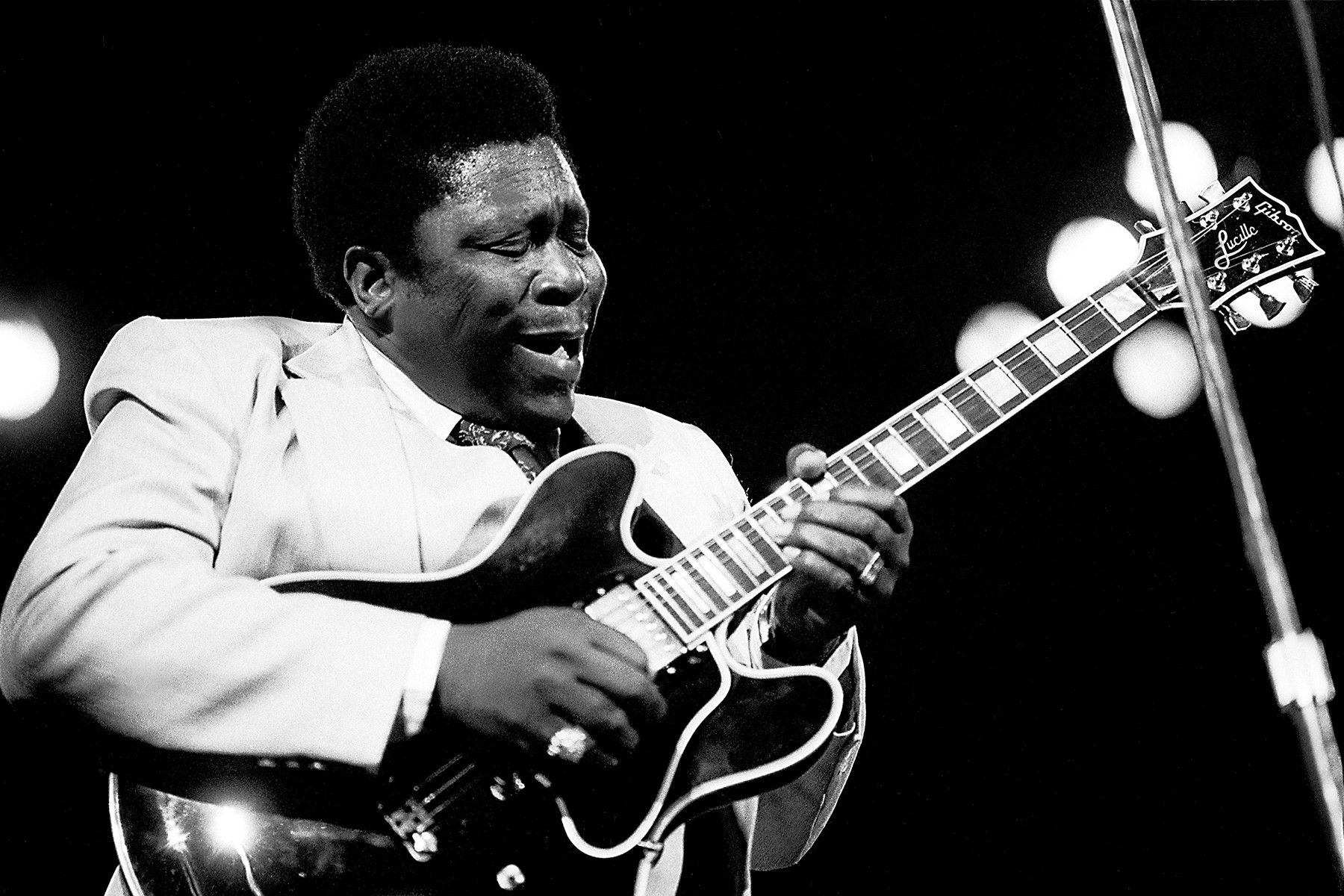 B.B. King performing at the Rosemont Horizon, Illinois in 1980.
B.B. King performing at the Rosemont Horizon, Illinois in 1980.
The “Ambassador of the Blues,” B.B. King, was so beloved that it’s easy to overlook his revolutionary guitar work. Buddy Guy stated, “Before B.B., everyone played the guitar like it was an acoustic.” King made his famous Gibson “Lucille” weep with human emotion. From the opening notes of his 1951 breakthrough hit, “Three O’Clock Blues,” his innovative, fluid style is evident. King’s string-bending and vibrato originated with his idol T-Bone Walker, but he took them to new heights, influencing generations of guitarists. “Every electric guitarist you listen to, there’s a little bit of B.B. in there,” Guy observed. “He was the father of squeezing the string on the electric guitar.”
King grew up on a Mississippi Delta plantation, learning country blues from his cousin Bukka White. He moved to Memphis in 1948, becoming a radio DJ and developing his eclectic blues style, incorporating gospel and jazz elements. His 1965 Live at the Regal remains a benchmark for live guitar performance. King toured relentlessly into his late eighties, always with Lucille. “Lucille don’t want to play anything but the blues,” King said. “Lucille is real. When I play her, it’s almost like hearing words, and of course, naturally I hear cries.” B.B. King’s expressive vibrato, string bending, and deeply human guitar voice redefined blues guitar and influenced countless musicians.
Key Tracks: “Every Day I Have The Blues,” “Sweet Sixteen,” “The Thrill Is Gone”
Nile Rodgers
 Nile Rodgers performing in his "Let's Dance" suit.
Nile Rodgers performing in his "Let's Dance" suit.
Nile Rodgers’ influence transcends mere “influential”—it’s massively foundational. The history of pop music over the last half-century is intertwined with Rodgers’ guitar. The manic-staccato funk jangle he pioneered with Chic, in 1970s disco hits like “Le Freak” and “Good Times,” has become a cornerstone of global pop. His warp-speed guitar on Diana Ross’s 1980 classic “I’m Coming Out” remained cutting-edge decades later, sampled by Biggie for “Mo Money Mo Problems.” That’s enduring impact.
He founded Chic with bassist Bernard Edwards, inspired by Roxy Music. “When I first started, all I played was super heavy-duty rock & roll,” Rodgers told Rolling Stone in 1979. “To be Hendrix or Jimmy Page was success to me.” His dynamic Stratocaster powers classics he created for Ross (“Upside Down”), Sister Sledge (“We Are Family”), David Bowie (“Let’s Dance”), Duran Duran (“Notorious”), and Daft Punk (“Get Lucky”). His riffs even launched hip-hop—The Sugarhill Gang rhymed over “Good Times” for the first rap hit, “Rapper’s Delight.” His impact is pervasive, from his jazzy chords to his powerful rhythms. He was a major influence on The Smiths—Johnny Marr called Rodgers his hero, even naming his son “Nile.” A true innovator, Nile Rodgers continues to make musical history with his guitar.
Key Tracks: “Le Freak,” “Good Times,” “I’m Coming Out”
Sister Rosetta Tharpe
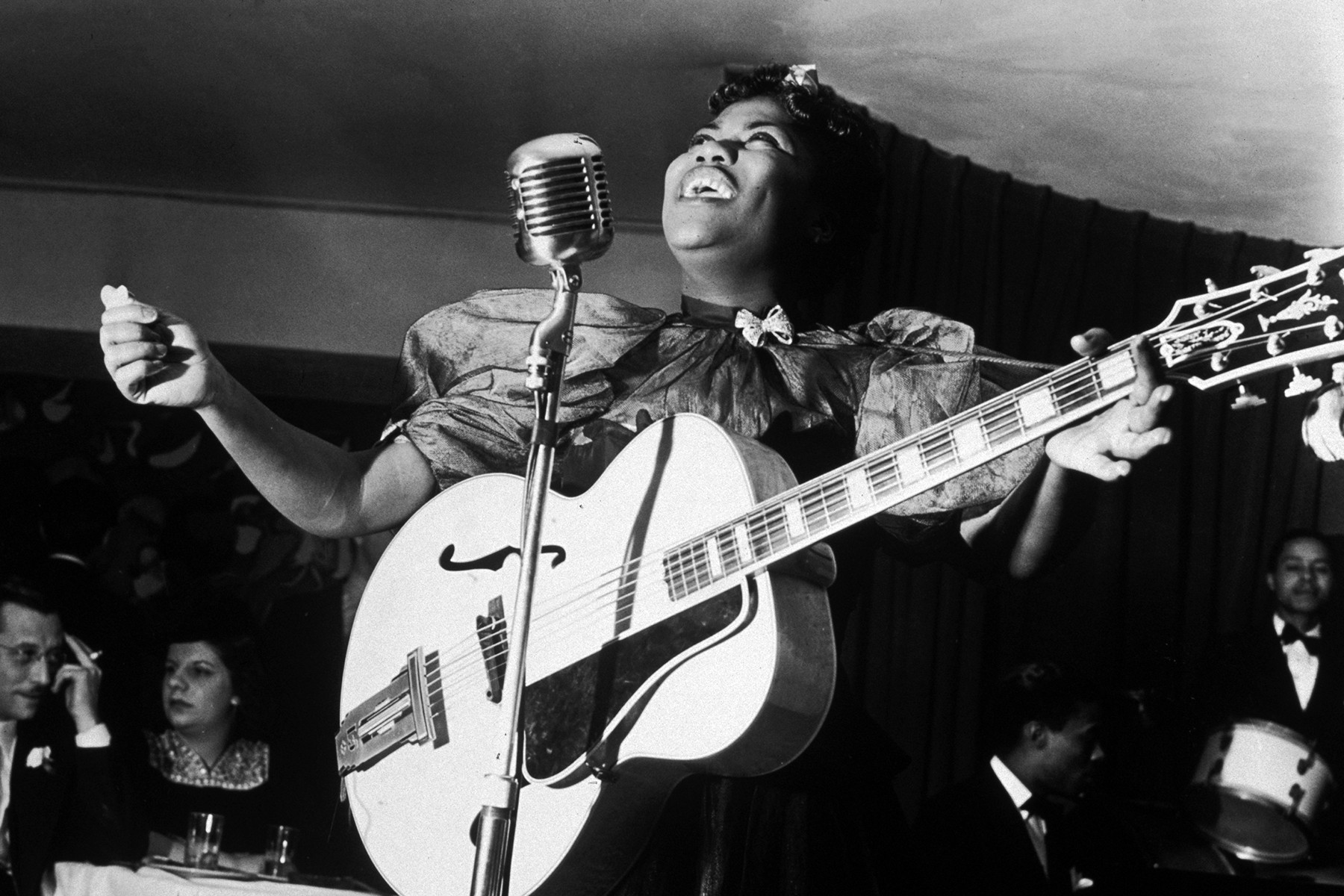 Sister Rosetta Tharpe performing at Cafe Society Downtown, New York City in 1940.
Sister Rosetta Tharpe performing at Cafe Society Downtown, New York City in 1940.
Sister Rosetta Tharpe, a sexually fluid Black woman who brought gospel music into the mainstream, shattered numerous social barriers. Before rock & roll existed, she essentially invented the concept of the guitar hero. Bob Dylan described her as a “powerful force of nature — a guitar-playing, singing evangelist.” Inspired by her mother’s mandolin playing, Tharpe learned guitar around kindergarten in Arkansas before moving to Chicago. By her 1930s recordings, her mastery was clear. Her picking and arpeggios on 1945’s “Strange Things Happening Every Day” perfectly matched the song’s boogie-woogie energy and her vibrant vocals. Her solos, as in the gospel anthem “Up Above My Head,” were powerful and dynamic. In 1964, Eric Clapton, Keith Richards, and Jeff Beck reportedly traveled to a Manchester train station to witness Tharpe perform for a televised special. Her rousing rendition of “Didn’t It Rain” showcased both her gospel roots and her effortless guitar virtuosity. Tharpe died in 1973, but her legacy endures. Brittany Howard inducted Tharpe into the Rock & Roll Hall of Fame as an early influence, recognizing her profound impact on music.
Key Tracks: “Strange Things Happening Every Day”
Jeff Beck
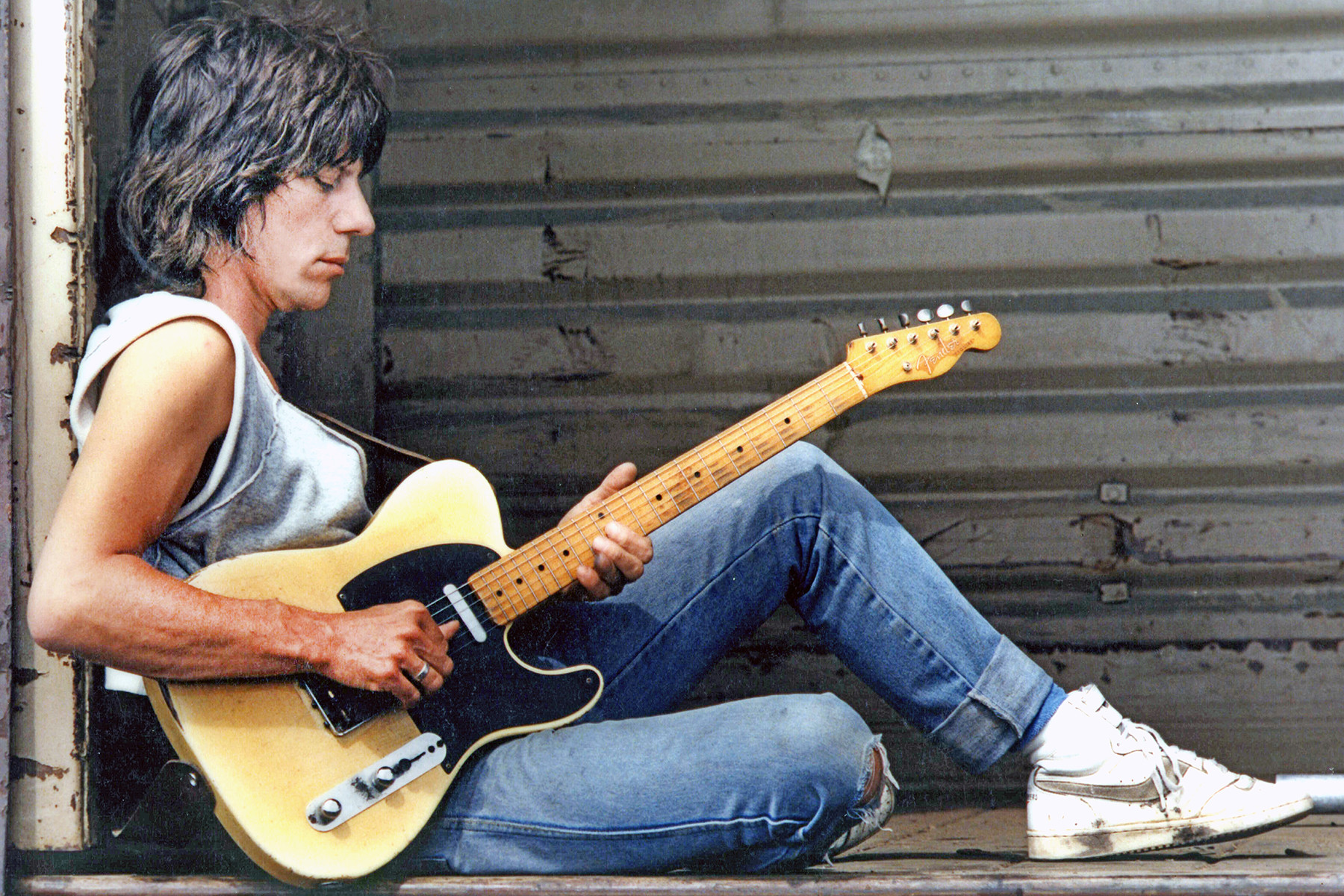 Jeff Beck playing a Fender Telecaster guitar in 1985.
Jeff Beck playing a Fender Telecaster guitar in 1985.
Jeff Beck never aspired to be a conventional guitar hero. He left the Yardbirds, disbanded the Jeff Beck Group (declining Woodstock), and let other bands dissolve before fame. Yet, his passion for guitar playing remained unwavering. His technique rapidly evolved from blues mastery with the Yardbirds and Jeff Beck Group to using a wah-wah to make his Stratocaster sing on the instrumental “Beck’s Bolero.” A constant sonic innovator, Beck found inspiration in jazz fusion in the mid-1970s, focusing entirely on guitar for Blow by Blow, an instrumental album showcasing his whammy bar techniques, grace notes, and pitch bends mirroring R&B singer Syreeta’s voice on “‘Cause We’ve Ended As Lovers.”
He refined his ability to mimic the human voice on guitar: the stinging pride in his “People Get Ready” solo, the shimmering, almost weeping tones of “Nadia,” and his sighing, swooning renditions of “Over the Rainbow” and “Nessun Dorma.” “[I’ve] never made the big time, mercifully probably,” Beck reflected in 2018. “When you look around and see who has made it huge, it’s a really rotten place to be when you think about it. Maybe I’m blessed with not having had that.” Jeff Beck’s constant sonic exploration, vocal-like guitar phrasing, and genre-bending approach made him a guitarist’s guitarist and a true innovator.
Key Tracks: “Beck’s Bolero,” “Freeway Jam,” “‘Cause We’ve Ended As Lovers”
Eddie Van Halen
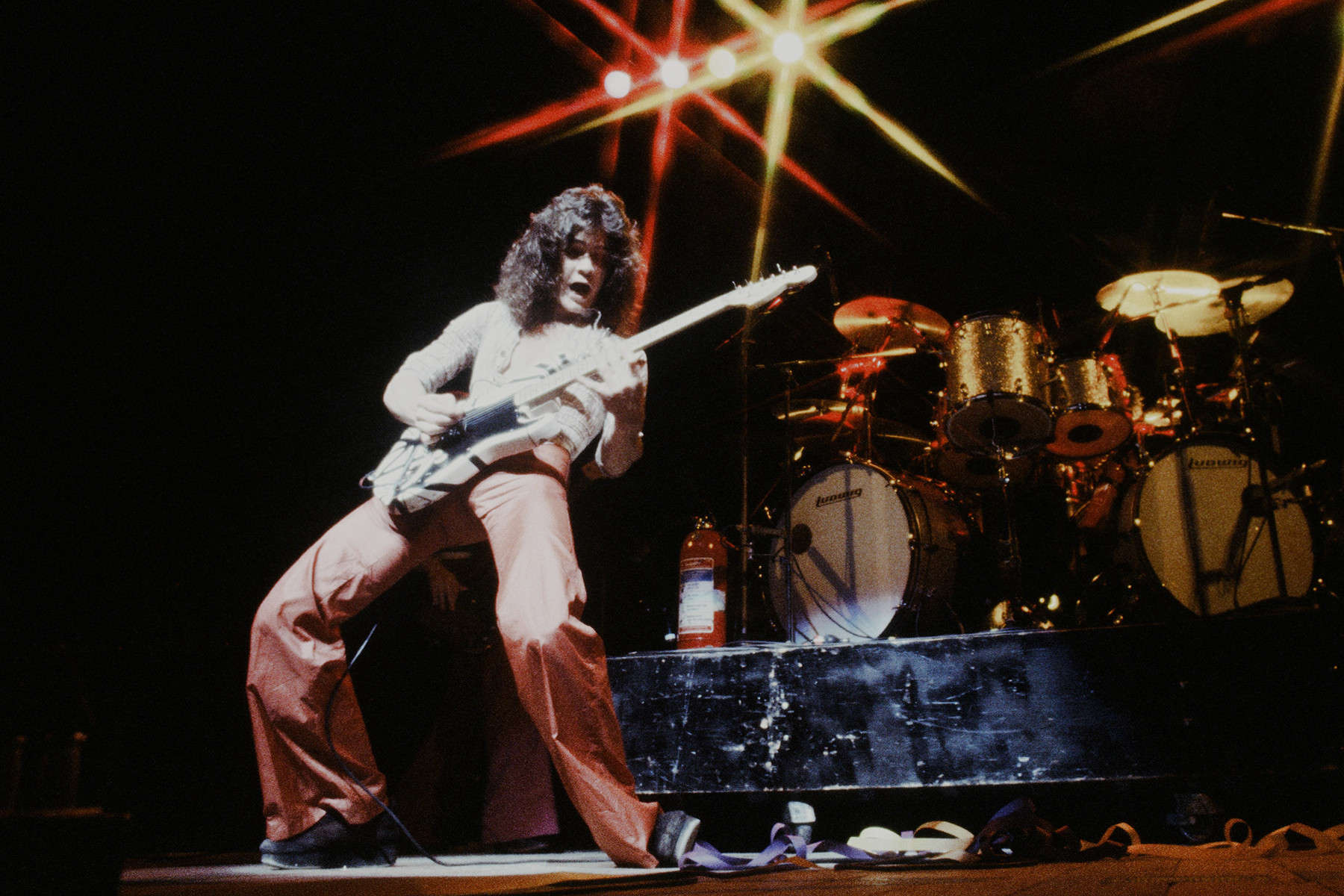 Eddie Van Halen performing in Tokyo, 1978.
Eddie Van Halen performing in Tokyo, 1978.
If “Eruption” were Eddie Van Halen’s sole release, it would have secured his guitar pantheon status. With finger-tapped, piano-like cascades, dive bombs, and trumpet-like calls, “Eruption” demonstrated the guitar’s untapped potential. But Van Halen’s true genius lay in transforming these techniques into singalong anthems: “Ain’t Talkin’ ‘Bout Love,” “Dance the Night Away,” “Everybody Wants Some!!,” “Jump”—tunes blending Van Halen’s technical brilliance with David Lee Roth’s flamboyant lyrics.
Beyond party anthems, solos like “Spanish Fly,” “Cathedral,” and “Little Guitars” were compositions in themselves. He never stopped experimenting, even recording an electric drill next to his pickup for “Poundcake.” Tom Morello said after Van Halen’s death, “With Eddie Van Halen, everyone was riveted. Because everyone knew we were in the presence of our generation’s Mozart.” Even when not playing, Van Halen innovated, building his “Frankenstrat,” inventing a floating whammy bar, and securing patents, fundamentally changing guitar design. Remarkably, he was self-taught. Eddie Van Halen’s revolutionary techniques, songwriting, and instrument innovations redefined guitar playing for generations.
Key Tracks: “Eruption,” “Ain’t Talking ‘Bout Love,” “Hot for Teacher”
Jimmy Page
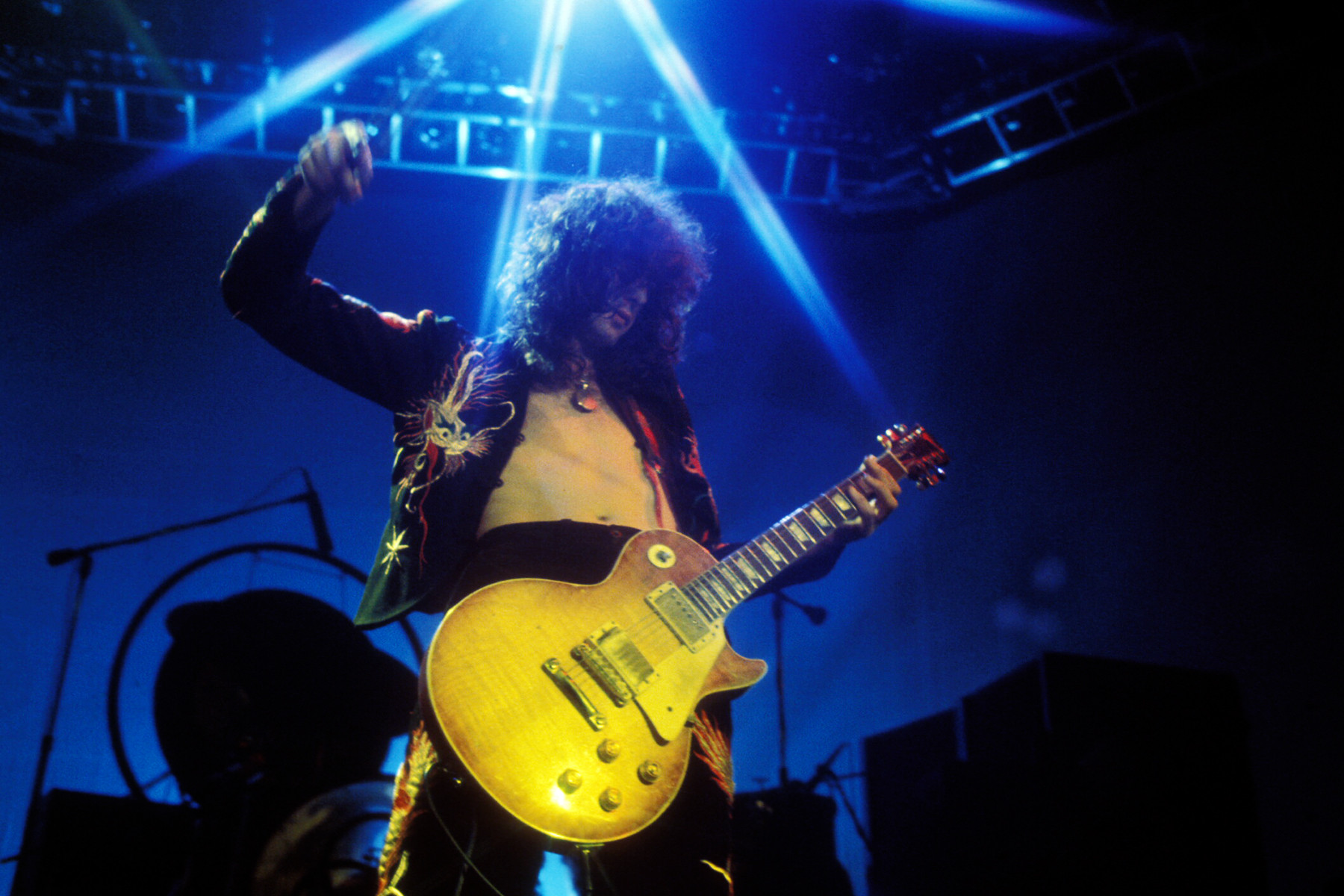 Jimmy Page of Led Zeppelin performing at Earl's Court, London.
Jimmy Page of Led Zeppelin performing at Earl's Court, London.
Before Led Zeppelin, Jimmy Page had already significantly impacted rock through his playing in the Yardbirds and as a sought-after London session guitarist. In his early twenties, Page was the go-to guitarist for records by The Who, The Kinks, Donovan, Marianne Faithfull, and many others. But in 1968, forming Led Zeppelin with Robert Plant, John Paul Jones, and John Bonham cemented his status as a rock guitar god.
With Led Zeppelin, everything about Page became legendary—from his dragon suit to his occult interests—but his blazing riffs were always central. “Communication Breakdown” and “In the Evening” riffs are instantly recognizable and enduring. “A riff ought to be quite hypnotic, because it will be played over and over again,” he told Rolling Stone in 2012. His playing also had delicate moments, like the fingerpicking in “Going to California” and “Stairway to Heaven’s” intro. Aerosmith’s Joe Perry observed, “He had this vision to transcend the stereotypes of what the guitar can do. If you follow the guitar on ‘The Song Remains the Same’ all the way through, it evolves through so many different changes—louder, quieter, softer, louder again. He was writing the songs, playing them, producing them—I can’t think of any other guitar player since Les Paul that can claim that.” Jimmy Page’s iconic riffs, studio innovation, and songwriting contributions established him as one of rock’s most influential guitarists.
Key Tracks: “Achilles Last Stand,” “Kashmir,” “No Quarter”
Chuck Berry
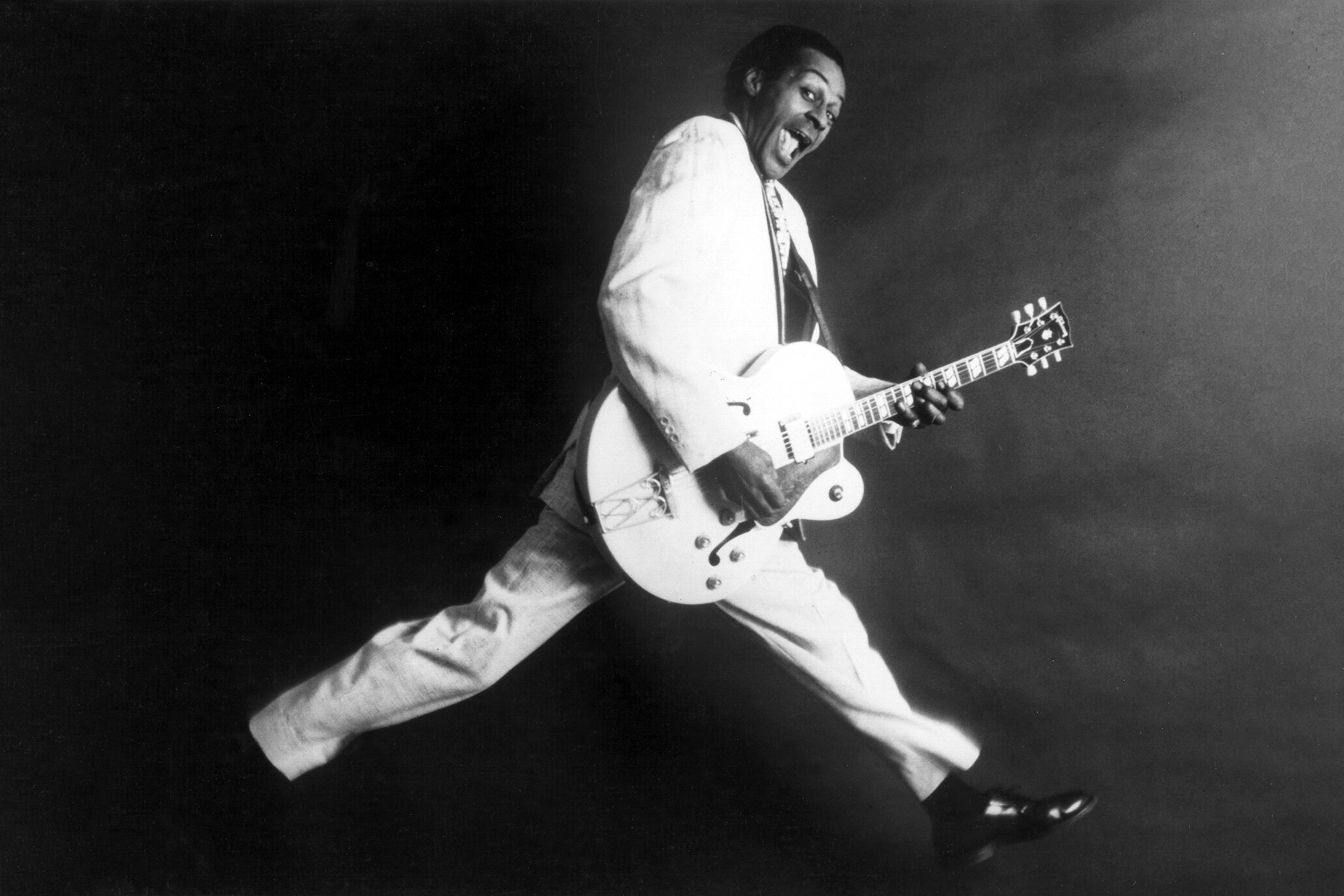 Chuck Berry holding his Gibson guitar, circa 1958.
Chuck Berry holding his Gibson guitar, circa 1958.
Chuck Berry didn’t just invent rock & roll guitar—he perfected it. His intro to 1956’s “Johnny B. Goode,” an 18-second guitar manifesto, defines the guitar hero anthem. He fused blues and country, boogie-woogie and hillbilly twang, into high-speed electric flash—in essence, rock & roll. Every American music tradition is present in Chuck Berry’s guitar. Keith Richards declared, “Chuck is the granddaddy of us all.”
A St. Louis hairdresser when he cut his revolutionary 1955 debut hit, “Maybellene,” for Chess Records, Berry claimed to have copied Bob Wills’ country classic “Ida Red.” But he created something entirely new, igniting the world. He defined rock & roll with a barrage of genius hits: “Roll Over Beethoven,” “You Can’t Catch Me,” “Little Queenie,” “Brown Eyed Handsome Man.” His riffs begat The Beatles, Stones, Hendrix, Zeppelin, The Velvet Underground, and The Clash. Imprisoned in the early 1960s, he wrote the ironic “Promised Land.” By Woodstock, he celebrated his hippie fanbase with the 1970 stoner anthem “Tulane.”
“There’s nothing new under the sun,” Berry stated in the 1987 film Hail! Hail! Rock ‘n’ Roll. Of his guitar playing, he said, “It’s just a washboard of time passing.” A fitting summary of Chuck Berry’s monumental achievements. Chuck Berry’s foundational rock and roll riffs, showmanship, and songwriting defined the genre and influenced generations of musicians.
Key Tracks: “Maybellene,” “Johnny B. Goode,” “Brown Eyed Handsome Man”
Jimi Hendrix
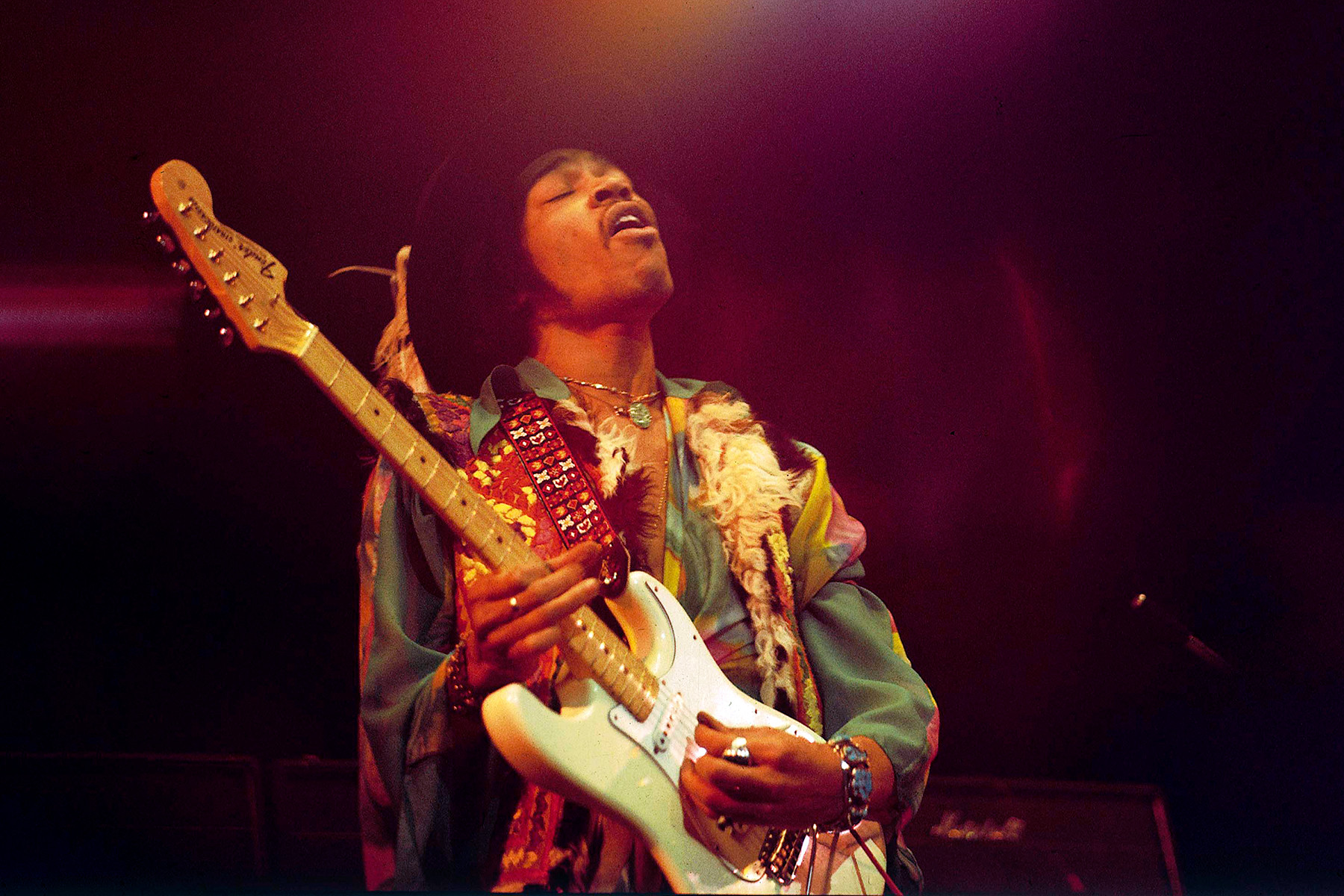 Jimi Hendrix performing at the Royal Albert Hall, London in 1969.
Jimi Hendrix performing at the Royal Albert Hall, London in 1969.
Jimi Hendrix setting his Fender Stratocaster ablaze at Monterey Pop is an iconic rock image. A showman playing with his teeth and behind his back, beneath the theatrics was a true master. His career lasted only eight years, but musicians spend lifetimes studying his technique and improvisational genius. Hendrix sang, but his guitar was his primary voice. He popularized feedback, invented blues-psychedelia fusion, and influenced rock, metal, funk, and more. Hendrix was eloquent about his playing. “The wah-wah pedal is great because it doesn’t have any notes,” he told Rolling Stone in 1968. “Nothing but hitting it straight up using the vibrato and then the drums come through and that there feels like … not depression, but that loneliness and that frustration and the yearning for something. Like something is reaching out.”
In a racially segregated music era, Hendrix—a Black artist awing white audiences—was a seismic cultural event. Decades after his death, his audience grows. Tom Morello stated, “Jimi Hendrix exploded our idea of what rock music could be. It’s impossible to think of what Jimi would be doing now; he seemed like a pretty mercurial character. Would he be an elder statesman of rock? Would he be Sir Jimi Hendrix? Or would he be doing some residency off the Vegas Strip? The good news is his legacy is assured as the greatest guitar player of all time.” Jimi Hendrix’s revolutionary technique, sonic innovation, and genre-bending approach cemented his legacy as the greatest guitarist of all time.
Key Tracks: “Purple Haze,” “Voodoo Child,” “Little Wing,” “The Star-Spangled Banner”

